Vol. 72, No. 15 (2023)
2023-08-05
ELECTROMAGNETISM, OPTICS, ACOUSTICS, HEAT TRANSFER, CLASSICAL MECHANICS, AND FLUID DYNAMICS
COVER ARTICLE
GENERAL

2023, 72 (15): 150201.
doi:10.7498/aps.72.20230501
Abstract +
Dispersive media refer to a class of natural substances, including living organisms, composite materials, plasma and water, with diverse applications in areas such as biomedicine, microwave sensing, electromagnetic protection, and stealth technology. In the pursuit of investigating the electromagnetic properties of these media, time-domain numerical methods, including finite difference in time domain (FDTD), finite element method, and time domain boundary integral equation method, have been widely utilized. Time-domain numerical methods are preferred to their frequency-domain counterparts owing to their ability to handle nonlinear and wideband problems, as well as various material properties. The FDTD method, in particular, is a highly adaptable, robust, and easy-to-use numerical method that directly solves the Maxwell equations while also simulating the reflection, transmission, and scattering of electromagnetic waves in complex dispersion media. Nonetheless, the traditional FDTD method suffers low computational efficiency arising from the Courant-Friedrichs-Lewy (CFL) stability condition. To solve the problem of low computational efficiency, a new method, the complying divergence implicit finite-difference time-domain (CDI-FDTD) method with a one-step leapfrog scheme, is introduced for lossy Debye dispersive media. The Maxwell equations in the frequency domain form a starting point, and the Fourier transform is utilized to transform the electromagnetic field components from the frequency domain to the time domain. To approximate the integral terms arising from the frequency-to-time domain transformation, a recursive integration (RI) method is employed. Subsequently, the time-domain Maxwell equations and auxiliary variables are discretized with a one-step leapfrog implicit scheme. The iterative formula of the RI-CDI-FDTD algorithm for lossy Debye dispersive media is then derived. The RI-CDI-FDTD method does not change the formulas of the traditional CDI-FDTD method while only requiring to add auxiliary variables for updating field components to the dispersive medium region. The numerical implementation is straightforward, and the electromagnetic modeling is flexible. Moreover, the unconditional stability of the RI-CDI-FDTD algorithm is proven by using the von Neumann method. Finally, some numerical examples are presented to demonstrate the effectiveness and efficiency of the proposed method. In conclusion, our work contributes a crucial numerical simulation tool to accurately modeling complex dispersive media while providing a systemic stability analysis method for time-domain numerical methods.
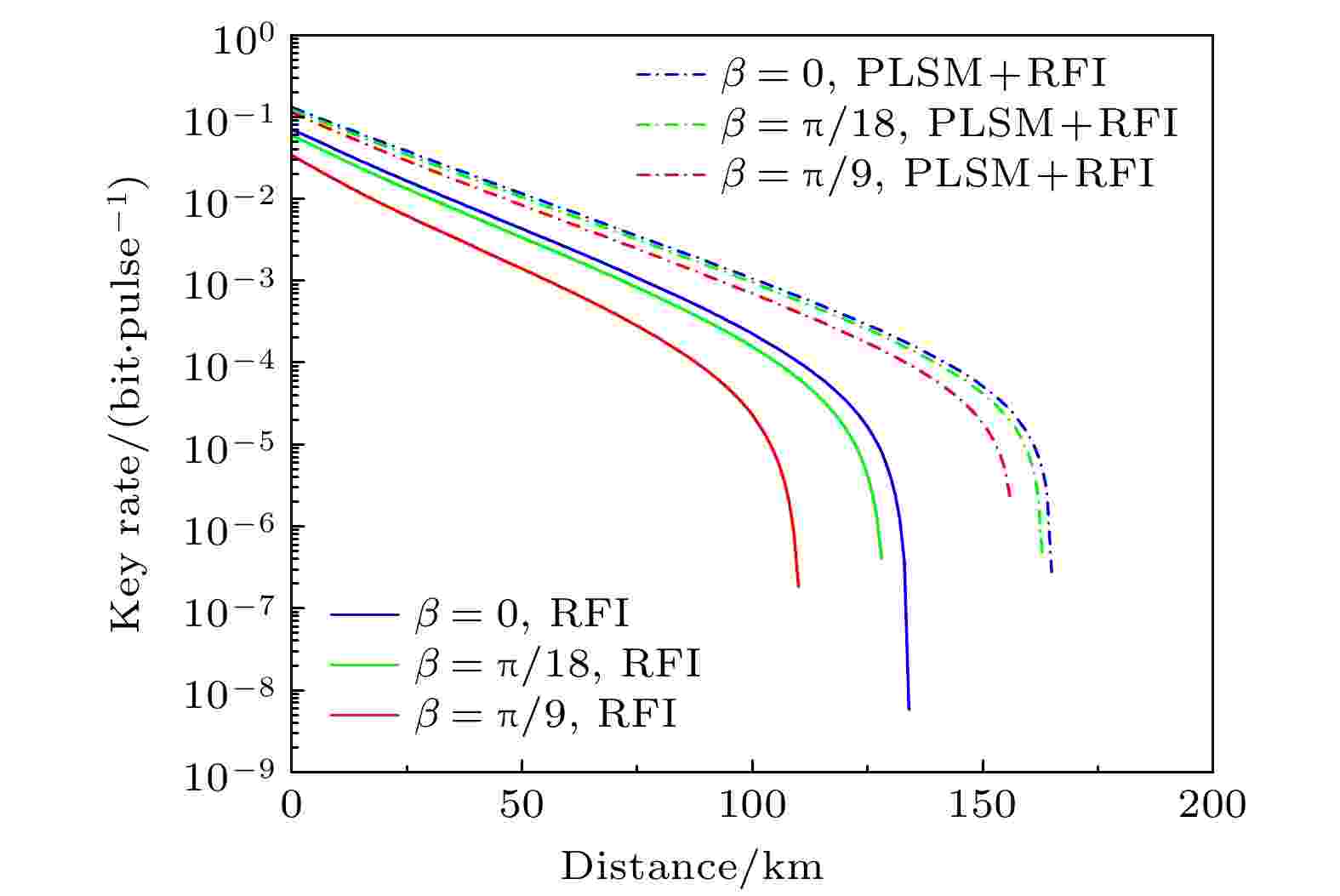
EDITOR'S SUGGESTION
2023, 72 (15): 150301.
doi:10.7498/aps.72.20230609
Abstract +
In quantum key distribution (QKD), the users need to share the same reference frame. If their reference frames are inconsistent, the QKD system will not function properly. The most widely used method today is the active real-time calibration of both communication reference frames by using classical communication. In order to get rid of the real-time calibration operation of the reference frames, a QKD protocol independent of reference frame is proposed, called reference-frame-independent QKD (RFI-QKD). The RFI-QKD protocol is immune to the effects of slowly changing reference frame drift, requiring that only one set of bases should be aligned by Alice and Bob, and the remaining two sets of bases can slowly change in the channel. In the real QKD system, a set of basis vectors can always be found to maintain a stable alignment. However, some assumptions are made for the sources in most reported researches, i.e. with a trusted and fixed photon-number distribution (PND), which usually cannot be satisfied in practical implementations. Those unreasonable assumptions will inevitably compromise the security of practical QKD systems. To solve the problem, in this work, we present a passive light source monitoring (PLSM) scheme for RFI-QKD, which is accomplished by a passive monitoring module consisting of a beam splitter and two detectors on the source side. Through the PLSM module, we can have four monitoring events by using two local detectors and then precisely estimate the bounds of source distributions. Specifically, we take the three-intensity decoy-state-based RFI-QKD for example for illustraing the events. Compared with the original RFI-QKD, our PLSM method can passively monitor the PND and has many advantages, with light source fluctuations, finite-size effects and reference frame deflection angles taken into account.
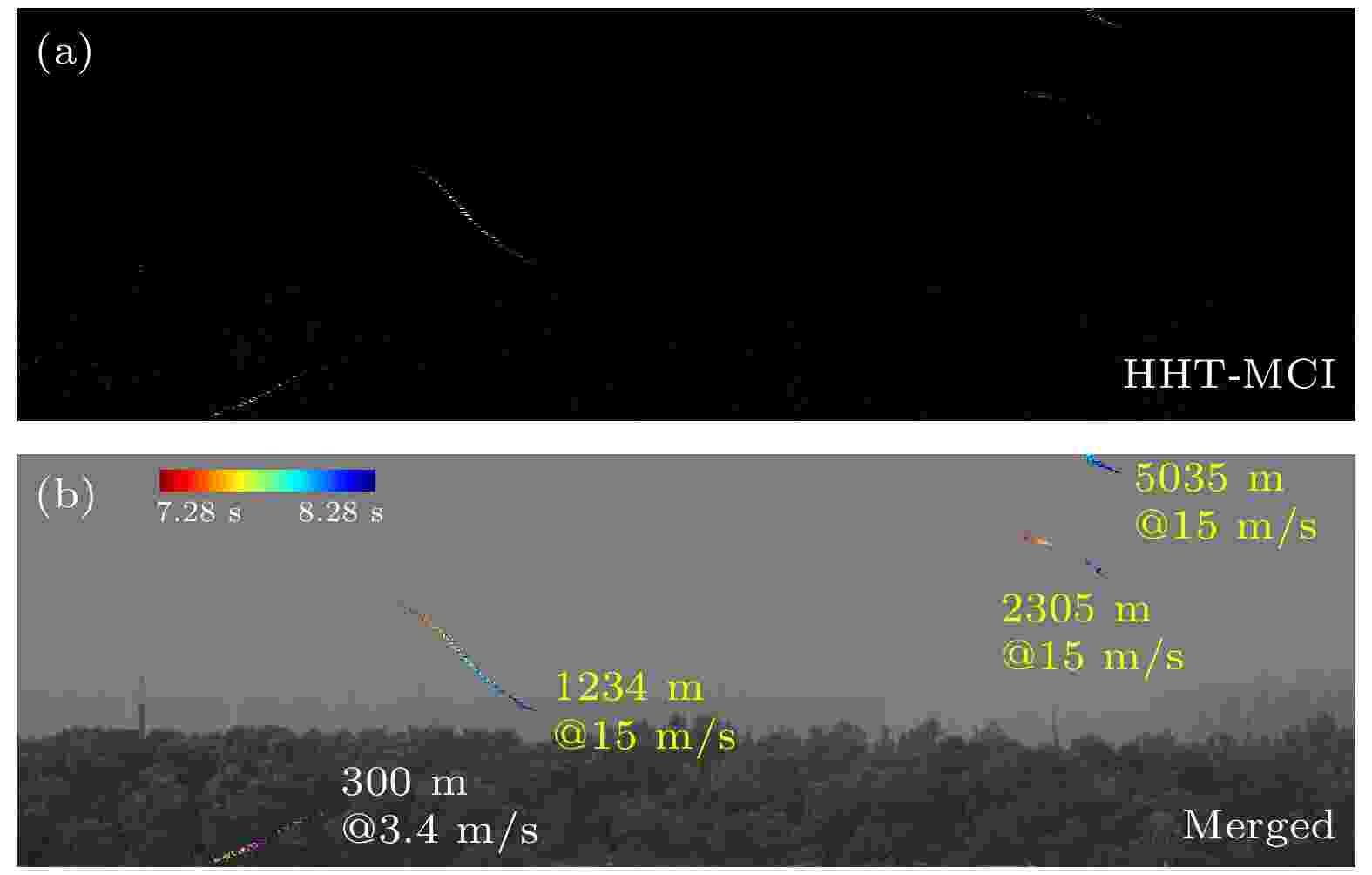
2023, 72 (15): 150701.
doi:10.7498/aps.72.20230360
Abstract +
Tracking of low-visibility targets in complex backgrounds is an important research field, where existing methods struggle to image low-visibility targets with irregular changes in moving direction and speed. Move contrast imaging can greatly improve the sensitivity of target tracking, which has achieved important applications in the field of X-ray imaging, including high-resolution imaging to microvessels in living rats with the help of contrast agents,in-situdynamic observation of ion migration and redox reactions during electrochemical reactions, and water refilling along vessels in willow branch without resorting to agents. However, all these applications are limited to imaging with fixed trajectories or monotonous backgrounds. In principle, move contrast imaging is based on the frequency spectral characteristics of the time-domain grayscale signal and is highly sensitive to moving components, which is wavelength-independent. This paper extends the move contrast imaging to the visible light waveband for tracking free-moving targets in time-varying complex backgrounds. To meet the need for tracking imaging of free-moving targets in complex backgrounds, we develop a move contrast imaging (MCI) method based on continuous wavelet transform (CWT) and Hilbert-Huang transform (HHT) with high discriminatory capability for non-stationary signals. Selecting birds in the sky and forest for the tracking imaging, the irregular grayscale changes caused by natural light intensity in the wild field and random swaying of tree leaves result in complex imaging backgrounds. The tracing results of low-visibility free-moving targets show that FT-MCI method, CWT-MCI method and HHT-MCI method can improve the target tracing imaging sensitivity by 179.9 times, 175.8 times and 214.6 times compared with temporal subtraction imaging, respectively. The results of tracking imaging of free-moving targets in complex backgrounds show that compared with the FT-MCI method and CWT-MCI method, the HHT-MCI method can further effectively suppress the influence of background noise on tracking imaging of targets of interest, thus achieving high sensitivity imaging of free-moving targets in time-varying complex backgrounds. Combining the phase diagram of FT-MCI and the imaging parameters, we can further show the motion direction, the motion speed or the distance from the observation point. Therefore, the HHT-MCI imaging method developed in this paper is expected to provide a novel method for tracking free-moving targets in time-varying complex backgrounds.
NUCLEAR PHYSICS
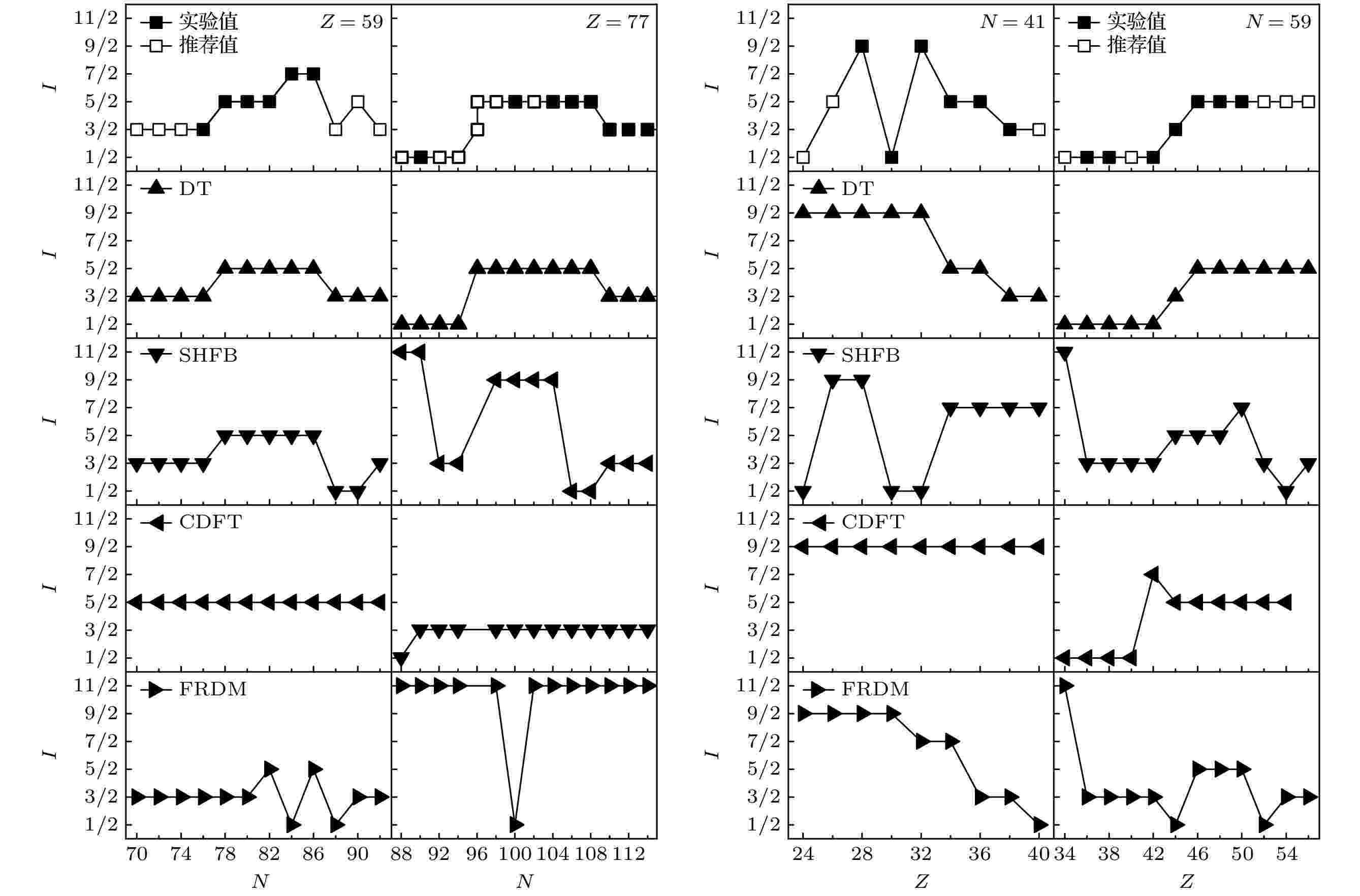
EDITOR'S SUGGESTION
2023, 72 (15): 152101.
doi:10.7498/aps.72.20230530
Abstract +
Ground-state spin, as a fundamental parameter of nucleus, has consistently been a hot topic in research on nuclear data and structure. In this paper, we extensively investigate the odd-mass nuclei (odd-Anuclei) on the nuclide chart by using decision trees, including odd-proton nuclei (odd-Znuclei) and odd-neutron nuclei (odd-Nnuclei), and train ground-state spin prediction models of odd-Znuclei and odd-Nnuclei. In the case of randomly dividing the training set and validation set in a ratio of 75% to 25%, the accuracy rate of the training set and validation set for odd-Znuclei reach 98.9% and 79.3%, respectively. The accuracy rate of the training set and validation set for the odd-Nnuclei reach 98.6% and 71.6%, respectively. At the same time, by 1000 random selections of training set and validation set, after being validated repetitively, the standard error of the accuracy rate obtained can be less than 5%, further verifying the reliability and generalization performance of the decision tree. On the other hand, the accuracy rate of decision tree is much higher than those of theoretical models commonly used in nuclear structure research, such as Skyrme-Hartree-Fock-Bogoliubov, covariant density functional theory, and finite range droplet model. Next, by taking all spin-determined odd-Znuclei and odd-Nnuclei as a learning set, the ground-state spin values for 254 spin undetermined but recommended odd-Znuclei and 268 spin undetermined but recommended odd-Nnuclei are predicted, with the predicted set coincidence rates reaching 68.5% and 69.0%, respectively. Finally, four odd-mass number chains, i.e.Z= 59,Z=77,N= 41, andN= 59, are selected to compare the learning (prediction) results of the decision tree with the experimental (recommended) values of the corresponding nuclei, and to discuss the differences and similarities in the results given by the three theoretical models, thereby further demonstrating the research and application value of the decision tree in the ground-state spin of nuclei.
ATOMIC AND MOLECULAR PHYSICS
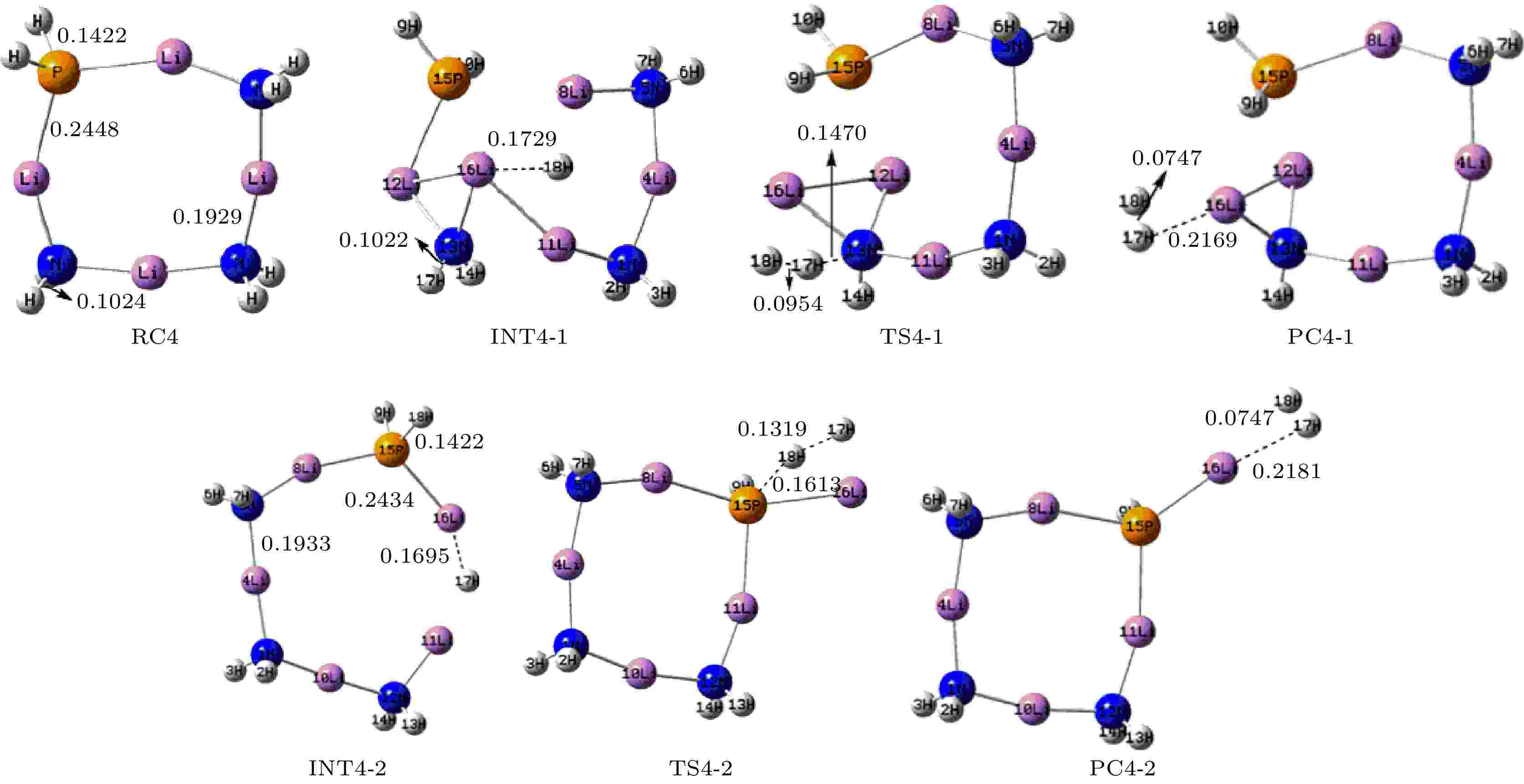
2023, 72 (15): 153101.
doi:10.7498/aps.72.20230374
Abstract +
Hydrogen energy is considered a clean energy with great development prospects. In the field of hydrogen energy applications, the solid-state chemical hydrogen storage method using hydrogen storage materials as media has received widespread attention due to its safety and high hydrogen storage density. In the research on metal-N-H system hydrogen storage materials, current studies focus on improving the kinetic conditions for hydrogen storage. In this study, the B3LYP hybrid functional method of density functional theory is used to investigate the reaction mechanism between P-doped LiNH2clusters and LiH at a cluster level, and explore the effects of doping, in addition a new hydrogen storage mechanism called “secondary hydrogen transfer” is proposed. The full-geometry optimization of (LiNH2)n(n= 1–4) clusters and their P-doped clusters at the 6-31G(d,p) basis set level are carried out, and their corresponding most stable configurations are obtained. The distribution and stability of the frontier orbitals of the relevant reactants are calculated. Using the same method and basis set, the theoretical calculation and analysis of the reaction mechanism between P-doped (LiNH2)n(n= 1–4) clusters and LiH are conducted, including the configuration optimization of the stationary points in each reaction path, and the correctness of the connection between the stationary points is determined through frequency and intrinsic reaction coordinate calculations. The results show that P doping has a small effect on the lowest unoccupied molecular orbital, while the highest occupied molecular orbital has a significant transition towards the doping atom, and the electron-deficient region is concentrated at the P atom. P doping reduces the stability of the lithium amide clusters and enhances their ability to participate in chemical reactions and reaction activity, and the reaction dehydrogenation energy barrier decreases. The reaction dehydrogenation energy barrier between P-doped LiNH2clusters and LiH is significantly lower than that between LiNH2and LiH, which is consistent with the analysis of reactant stability. Additionally, it is found that the reaction between P-doped LiNH2clusters and LiH tends to dehydrogenate through the —PH2functional group and store hydrogen at the —NH2functional group. Therefore, a new idea of “secondary hydrogen transfer” is proposed, in which effective transfer of hydrogen between —NH2and —PH2functional groups takes place during the cyclic hydrogen storage process, thus the reversibility of hydrogen storage is further improved and the hydrogen desorption energy barrier of the material is reduced.
ELECTROMAGNETISM, OPTICS, ACOUSTICS, HEAT TRANSFER, CLASSICAL MECHANICS, AND FLUID DYNAMICS
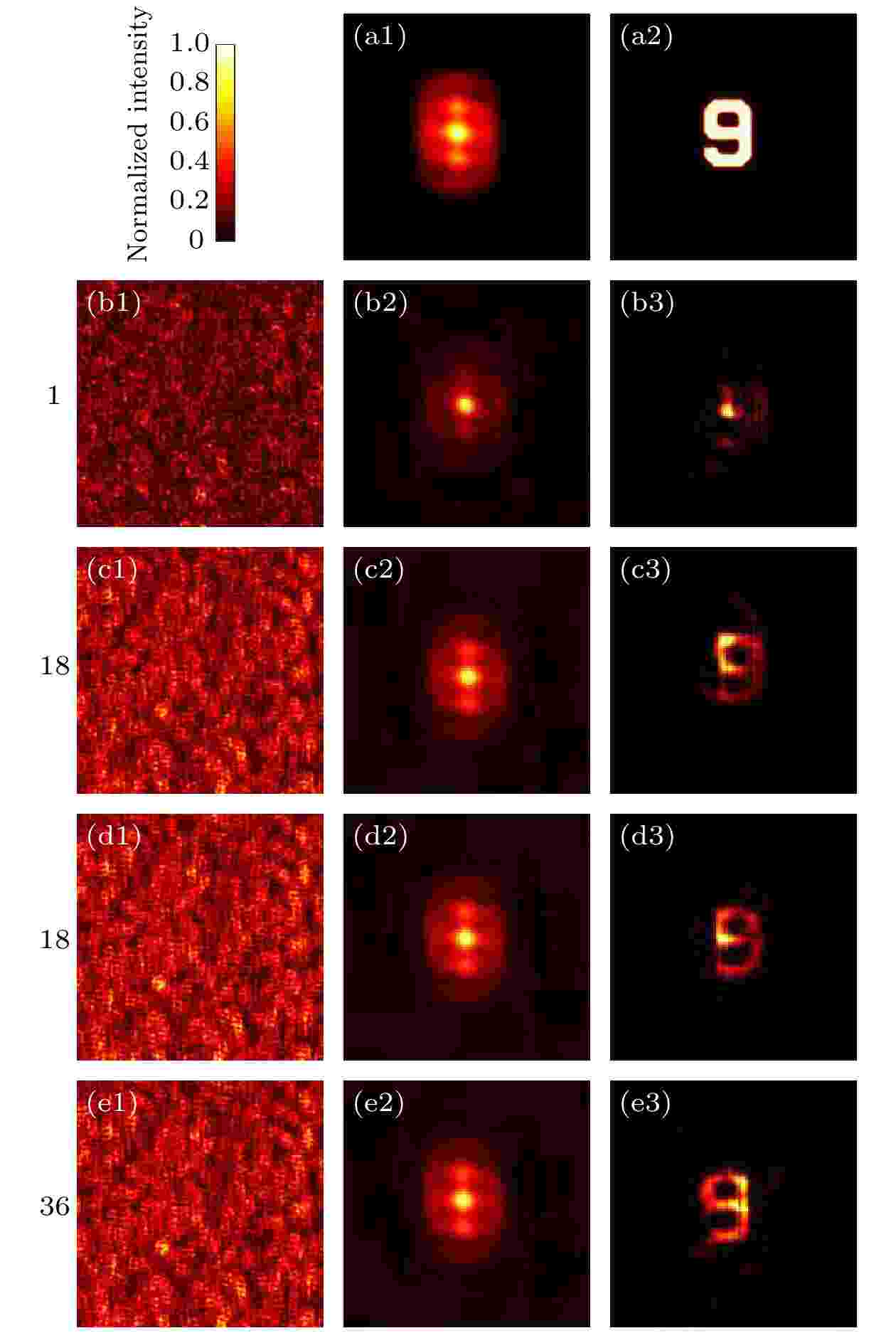
2023, 72 (15): 154201.
doi:10.7498/aps.72.20230551
Abstract +
Imaging through scattering media, such as clouds, biological tissues, and seawater, has broad application prospects in transportation, medical diagnosis, and information technology. Researchers have proposed various techniques to obtain images from scattered light passing through the scattering media, among which speckle correlation imaging has developed rapidly. Speckle correlation imaging requires non-coherent light sources due to the requirement of memory effect. This requirement makes the imaging device complex, and the light source utilization rate low. Additionally, this method is limited in its application under the illumination of spatially coherent light sources. This paper proposes a new method of speckle correlation imaging based on the illumination of spatially coherent light, which is achieved by multiplexing different polarization direction speckle patterns, called polarization multiplexing scattering imaging. To achieve the decoherence of the light source, previous approaches have used a rotating scattering medium to generate time-varying speckle patterns that are integrated over the shutter time of the camera to eliminate coherent noise, or multiplexed wavelength-dependent speckle multiplexing to achieve this. This paper uses spatially incoherent light sources to obtain different polarization direction speckle patterns by rotating polarizers placed in the illumination path. These patterns are superimposed and averaged, and phase recovery algorithm is used to reconstruct the object image. This experiment uses Ping-Pang (PP) algorithm with fusion error reduction and hybrid input-output algorithm to reconstruct targets quickly and with high quality. The comparison of the reconstruction results of different numbers of reused speckle patterns demonstrates that using more speckle patterns can achieve better image quality. Compared with conventional speckle correlation imaging technology, the proposed method reduces the requirements of light sources, improves the utilization rate of light sources, and makes the device simpler and more compact. Experimental results show that this method is feasible and has strong environmental adaptability, which can expand the application scope of speckle correlation imaging methods.

2023, 72 (15): 154202.
doi:10.7498/aps.72.20230603
Abstract +
An analytical solution model for ptychographic iterative engine (PIE) is proposed. In this model, PIE can be described as a system of linear equations between the sample and the illumination in the frequency domain. This system of linear equations (AX=B) is derived with the spectrum of the illumination as the coefficient (A), the spectrum of the sample as the unknown (X), and the intensity of the diffraction pattern as the vector (B). Hence, the sample can be recovered by solving this linear system. In PIE, the detector (such as Pike F-100, AVT) has a large resolution, meaning that 1000 × 1000 linear equations can be generated by recording a single pattern. It is still the case, however, that the number of obtained equations is smaller than the number of unknowns, leading to the inability to obtain a unique solution about the sample. Relative motions of sample and illumination, can generate more diffraction patterns to construct a sufficient number of linear independent equations. For coefficient (A), since the initial illumination is known, the illumination after shifting can still be obtained by recording its shifting distance. Hence the unique solution for the sample can be directly obtained by solving this linear independent system of equations. Simultaneously, the photoelectric parameters of the detector have a significant influence on the imaging quality of PIE. Using this linear system, the photoelectric parameters of the detector can be characterized by the number of linear equations and unknowns in each equation. According to the conditions that there is a unique solution in the system of equations and the requirements of the photoelectric parameters (such as pixel sampling interval, width of target surface, pixel size, sensitivity and dynamic range), the influence of the reconstruction for PIE is quantified theoretically. Obviously, the numerical simulation results based on this theory not only verify the correctness of the theoretical analysis and predictions, but also reveal the physical mechanism of recovering high-quality results in imperfect photoelectric parameters of detector, which can contribute to improving the quality of their reconstruction and optimizing the experimental setup.

Slow light effect caused by optomechanically induced transparency in multimode optomechanical system
2023, 72 (15): 154203.
doi:10.7498/aps.72.20230663
Abstract +
Owing to the radiation pressure, the cavity optomechanical system can couple the optical field with the mechanical resonator, so the state of the mechanical resonator can be regulated through the optical field. Conversely, the optical field in the optomechanical system can also be regulated by modulating the mechanical element. Therefore, many interesting optical phenomena, such as Fano resonance, optomechanically induced absorption and amplification, and optomechanically induced transparency, can be generated in a cavity optomechanical system. Especially in transparent windows, both absorption and dispersion properties change strongly, which results in extensive applications such as slow light and optical storage. Because of its ultra-high quality factor, small size, mass production on chip and convenient all-optical control, it provides an ideal platform for realizing slow light engineering. In this work, by solving the Heisenberg equation of motion of a multimode optomechanical system composed of an optical cavity and two mechanical oscillators, and then by using the input-output relationship for the cavity, the intensity of probe transmission can be obtained. Taking the experimental date as realistic parameters, the behaviors of probe transmission in different detuning conditions are presented. By controlling the pump power under blue detuning, the probe transmission undergoes a process of optomechanically induced absorption to parametric amplification, and the critical pump power is obtained. In the case of red detuning, optomechanically induced transparency, Fano resonance and phase dispersion of the system are studied, and the results of different mechanical coupling strengths, frequency relations and detuning are compared. The numerical results show that as the mechanical coupling strength between two mechanical oscillators increases, the splitting distance becomes larger, and a larger coupling strength ratio will result in a larger splitting peak width. By controlling the frequency relationship between the two resonators, the probe transmission spectra undergo a series of transitions from Fano resonance to optomechanically induced transparency. Because the transmission window of the probe light is accompanied by rapid phase dispersion change, it will lead to group delay. The slow light effect caused by optomechanically induced transparency is further discussed, and the propagation of fast and slow light can be controlled by pump-cavity detuning. The optical delay in this system can be in the order of milliseconds. The multimode optomechanical system based on array structure has a potential application prospect in slowing and storing light pulses.
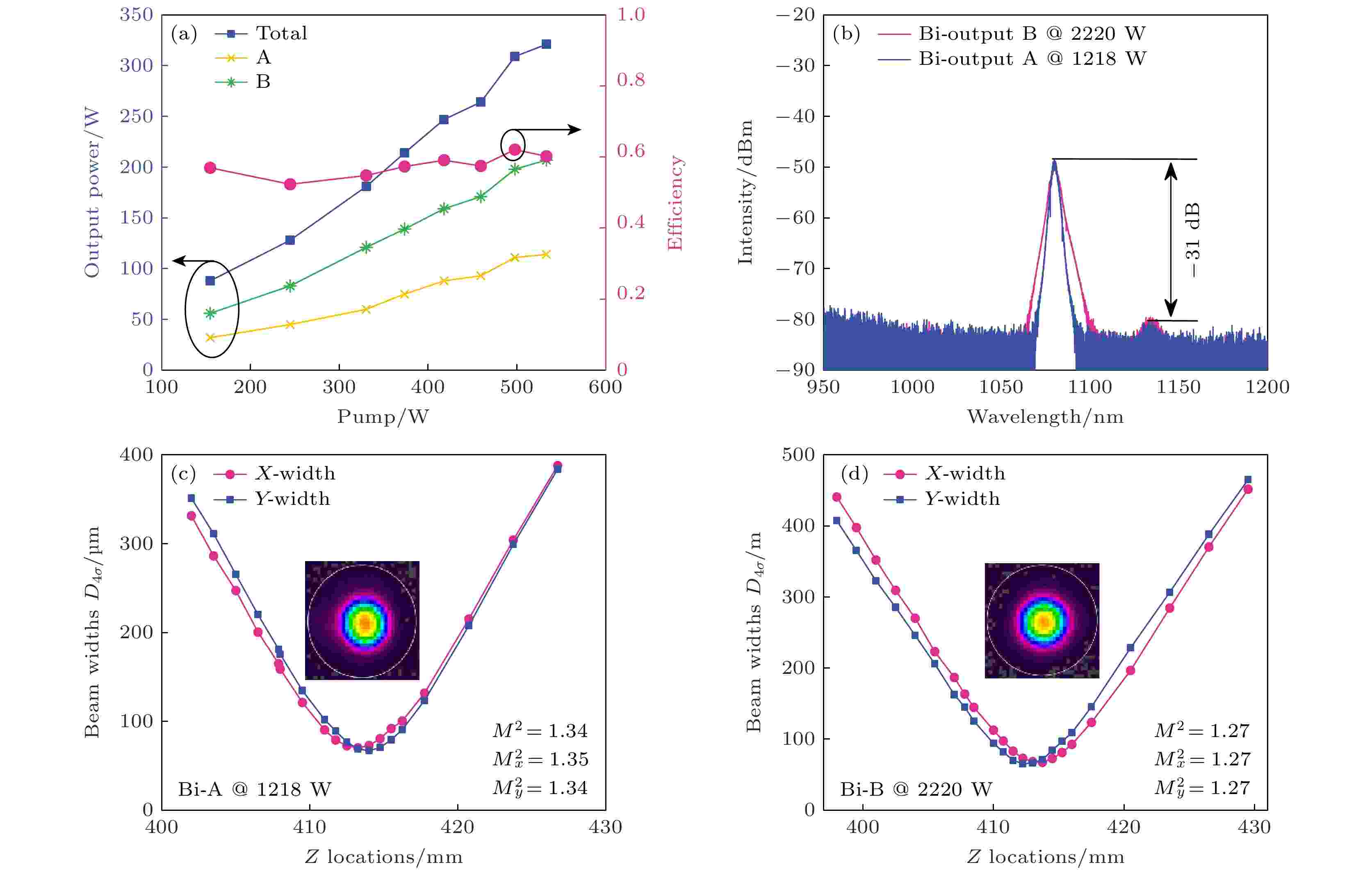
EDITOR'S SUGGESTION
2023, 72 (15): 154205.
doi:10.7498/aps.72.20230616
Abstract +
Quasi-continuous fiber lasers have a broad application prospect in the industrial field. However, in the current research on quasi-continuous wave (QCW) fiber lasers only the single-ended output structure is used. A double-ended output fiber laser oscillator needs only one resonator to realize two laser outputs. Compared with single-ended output laser, it has a low cost, small volume and high work efficiency. It is expected to achieve higher power laser output through double-ended output beam combining. Therefore, the double-ended output QCW fiber laser is proposed and studied in this paper. The steady-state rate equation establishes a theoretical model of a QCW fiber laser oscillator with two ends, considering the stimulated Raman scattering (SRS) and amplified spontaneous emission (ASE). The output power, time domain and nonlinear effects of this type of laser are simulated. The results show that the overshoot effect caused by relaxation oscillation will produce a large amount of thermal deposition and ultra-high peak power in the fiber. It will reduce the nonlinear threshold and limit the increase of power of the QCW fiber laser. Prolonging the rise time of the pump can effectively suppress the relaxation oscillation and obtain a stable pulse output during the pulse duration. In addition, compared with the single-ended QCW laser, the double-ended output structure changes the energy distribution in the fiber and reduces the accumulation of nonlinear effects in the gain fiber, thus inhibiting SRS. Then, the ytterbium-doped fiber with a core/cladding diameter of 20/400 μm is used to achieve the first double-ended QCW laser output with a peak power of 3 kW. The peak power values at both ends are 1218 and 2220 W, respectively. The values of corresponding beam quality factorM2are 1.34 and 1.27. The optical-to-optical conversion efficiency is about 60%. The pulse width is 100 μs, and the repetition frequency is 1 kHz. This research verifies the feasibility of high power and high beam quality output by double-ended output QCW fiber laser, which provides support for small volume, low cost, high power and high brightness QCW fiber laser. Further breakthroughs in the research and application of high-power fiber lasers are expected to be made by continually optimizing experiments, increasing pump power, and improving the laser’s output power and conversion efficiency.
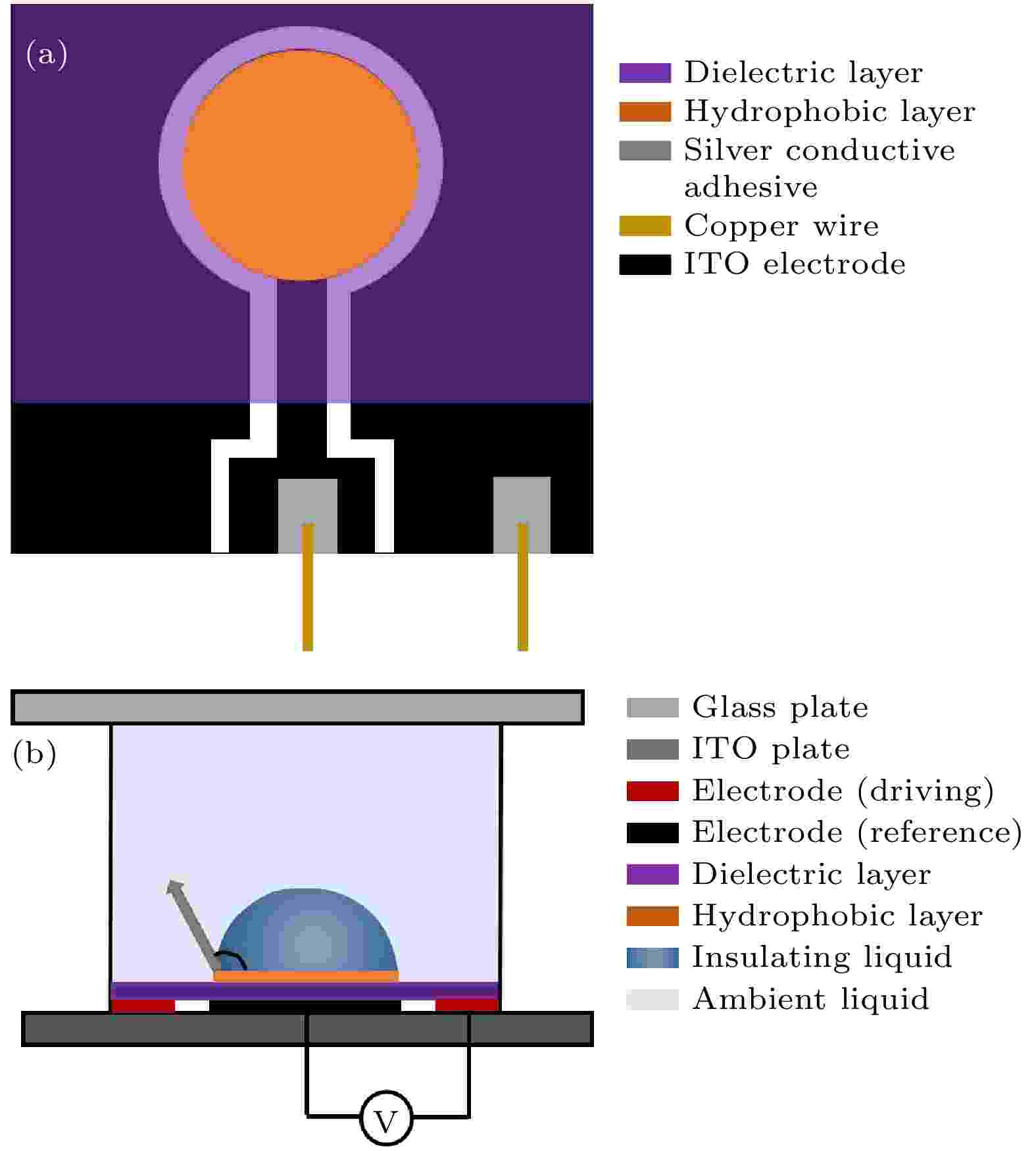
2023, 72 (15): 154206.
doi:10.7498/aps.72.20230758
Abstract +
In order to study an aspherical liquid lens with simple structure and easy realization, an aspherical double-liquid lens based on planar electrode is designed based on the dielectrophoretic effect. The droplet in the dielectric electrophoretic liquid lens is polarized in the electric field and moves towards the higher electric field strength under the action of the dielectrophoresis force. With the change of the applied voltage, the dielectrophoresis force also changes, thus the contact angle of the droplet at the solid-liquid interface changes. Firstly, the models of the aspherical double-liquid lens under different voltages are established with Comsol software, and the interfacial profile data are obtained. Then the aspherical coefficients and the surface type of the fitted interface are obtained with Matlab software. Finally, the corresponding optical model of double-liquid lens is established with Zemax software. The variable range of focal lengths and root mean square (RMS) radii of the aspherical double-liquid lens at different voltages are obtained. In order to further study the characteristics of the aspherical double-liquid lens, it is compared with a spherical double-liquid lens model. Based on the contact angle theory of liquid lens and Gaussian optics theory, the relationship between the interfacial curvature radius of the spherical liquid lens and the applied voltage, and the relationship between the focal length and the applied voltage are obtained, respectively. The liquid material, cavity structure and droplet are the same as those of the aspherical lens. The corresponding spherical double-liquid lens model is established according to the two expressions relating to Zemax, and the voltage value is the same as that of the aspherical lens. Thus, the variable ranges of focal length and RMS radius in the spot diagram of the spherical double-liquid lenses at different voltages are obtained. Then, they are compared with those of aspherical double-liquid lens, and the results show that the variable range of focal length of the aspherical double-liquid lens is larger than that of the spherical double-liquid lens, and the imaging quality of the former is better than that of the latter. Moreover, through the device fabrication and preliminary experimental analysis of the aspherical double-liquid lens, the imaging resolution can reach 40.318 lp/mm. The aspherical double-liquid lens proposed in this work has the characteristics of simple structure and easy realization, which can provide a new scheme for high-quality imaging of liquid lens and its applications, and can expand the application scope of liquid lens.

2023, 72 (15): 154207.
doi:10.7498/aps.72.20230459
Abstract +
Power splitter with multi-mode interference coupler structure has many advantages, such as large bandwidth and better manufacturing robustness, and has received much attention for a long time. Conventional power beam splitters usually use algorithms or numerical simulation to achieve a single beam splitting ratio; if the circuit has the requirement for power, the structural parameters of the device need changing and recalculating. In order to improve the utilization rate of power splitter in photonic integrated circuit and meet various demands for different optical paths, an ultra-compact tunable power splitter based on phase change material In2Se3with a 1×2 multimode interference coupler structure is proposed in this paper. The device consists of an input waveguide, a coupling region, and two output waveguides with a coupling region of only 2.4 μm× 3.6 μm in size, which contains several circular holes of the same size and is filled with SiO2. The number and location of circular holes in the coupling region are optimized by direct binary search algorithm, making the device achieve different power splitting ratios by using only the high refractive index contrast variation between the two crystalline states (αandβ) of In2Se3without changing any other structural parameter. In a wavelength range of 1540–1560 nm, three splitting ratios of 1∶1, 1∶1.5 and 1∶2 are achieved by this device, and the insertion losses of these three beam splitting ratios are less than 0.27, 0.13 and 0.17 dB, respectively. In addition, the robustness and balance of the device are analyzed and discussed, and compared with those of the power splitter of the same size designed by SOI platform and several power beam splitters reported in recent years, demonstrating the compact structure and simple regulation of this power splitter based on the phase change material In2Se3, its good robustness, and its possibility of application on photonic integrated circuits.

2023, 72 (15): 154301.
doi:10.7498/aps.72.20230522
Abstract +

2023, 72 (15): 154302.
doi:10.7498/aps.72.20230323
Abstract +
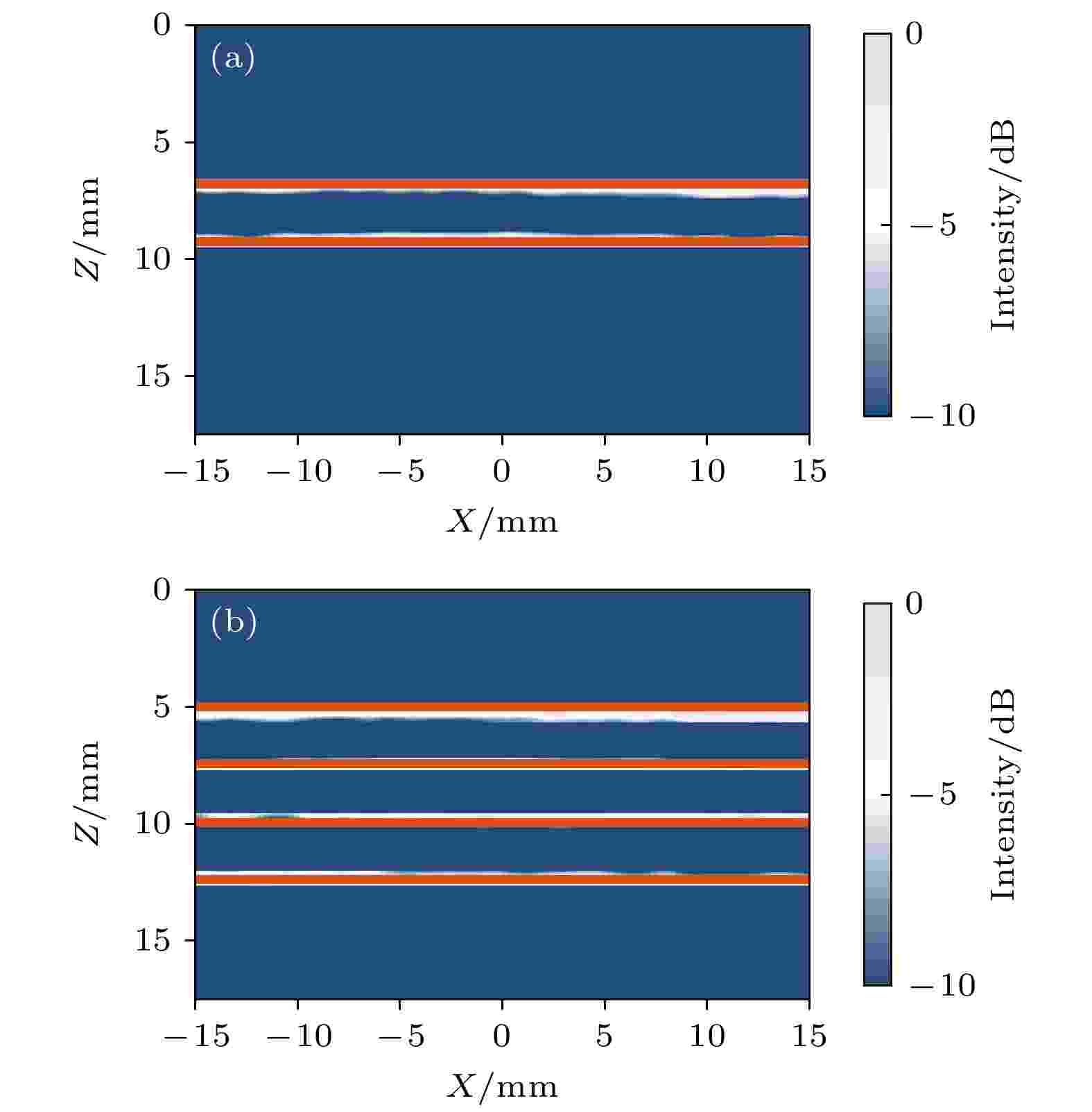
2023, 72 (15): 154303.
doi:10.7498/aps.72.20230581
Abstract +
Cortical bone, a highly attenuated, anisotropic, and multilayered biological medium with high acoustic impedance, presents significant challenges for high-frequency ultrasound to penetrate its complex structure and acquire high-quality images. The traditional method of using uniform sound velocity in ultrasonic dynamic focusing imaging is limited by emission energy and frame rate, which hinders the accurate and rapid reconstruction of multi-layer structures and clinical applications. In order to meet these challenges, this study proposes a novel method, called the phase shift migration-based plane-wave bone imaging via velocity inversion (PSM-PW-VI), that can accurately and quickly image the multi-layer structure of cortical bone. In the PSM-PW-VI method, two identical linear array probes are arranged in parallel on both sides of the cortical bone for data acquisition. First, the ultrasound velocity distribution in the imaging region is obtained by using ultrasound travel time inversion. Next, two images corresponding to the upper probe and lower probe are acquired in parallel in the frequency domain by employing a phase shift migration-based coherent plane-wave compounding method. Finally, the two images are merged to generate a complete ultrasound image of the cortical bone. Wave propagation in cortical bone is simulated by using the open source toolboxk-wave in MATLAB.Ex-vivoexperiments are conducted on 2.5-mm-thick sawbones phantom and 2.45-mm-thick bovine bone plates to evaluate the feasibility of the proposed method, by using the Verasonics platform. Simulation, phantom (Sawbones), andex-vivoexperiments validate the effectiveness of the method. Notably, the average error of the thickness is less than 0.2 mm, and the relative error is less than 7% for both three-layer and five-layer cortical bone. The influence of the number of plane wave compounding angles on imaging quality is investigated, revealing that only 15 angles are sufficient to produce high-quality images. The influence of the velocity model on imaging accuracy is also examined since accurate sound velocity estimation is crucial for obtaining high-quality images of cortical bone. Finally, the performances of PSM-PW-VI and PSM-SA in imaging depth and efficiency are compared. The results demonstrate that the proposed PSM-PW-VI method offers significant improvements in temporal resolution, data storage and processing quantity, emission energy, and imaging depth. The experimental findings validate the effectiveness of the proposed method as an accurate and efficient ultrasound imaging tool for cortical bone, and its substantial role in promoting ultrasound bone imaging technology and clinical applications.
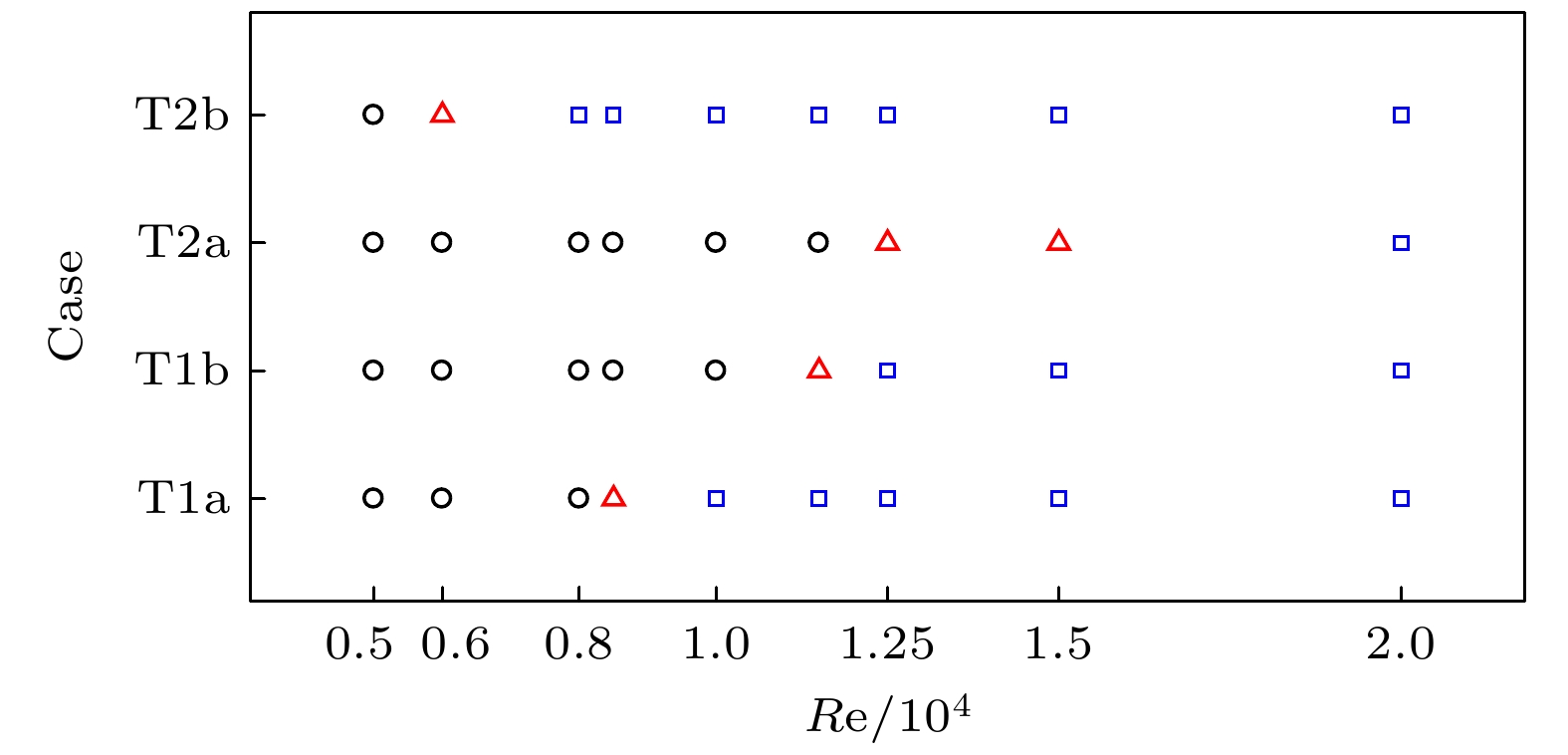
2023, 72 (15): 154701.
doi:10.7498/aps.72.20230430
Abstract +
In this study, we utilize the lattice Boltzmann method to investigate the flow behavior in a two-dimensional trapezoidal cavity, which is driven by both sides on the upper wall and lower wall. Our calculations are accelerated through GPU-CUDA software. We conduct an analysis of the flow field mode by using proper orthogonal decomposition. The effects of various parameters, such as Reynolds number (Re) and driving direction, on the flow characteristics are examined through numerical simulations. The results are shown below. 1) For the upper wall drive (T1a), the flow field remains stable, when theRevalue varies from 1000 to 8000. However, whenRe= 8500, the flow field becomes periodic but unstable. The velocity phase diagram at the monitoring point is a smooth circle, and the energy values of the first two modes dominate the energy of the whole field. OnceReexceeds 10000, the velocity phase diagram turns irregular and the flow field becomes aperiodic and unsteady. 2) For the lower wall drive (T1b), the flow is stable whenRevalue is in a range of 1000-8000, and it becomes periodic and unsteady whenRe= 11500. The energy values of the first three modes appear relatively large. WhenReis greater than 12500, the flow field becomes aperiodic and unsteady. At this time, the phase diagram exhibits a smooth circle, with the energy values of the first two modes almost entirely dominating the entire energy. 3) For the case of upper wall and lower wall moving in the same direction at the same speed (T2a), the flow field remains stable whenRechanges from 1000 to 10000. WhenRevaries from 12500 to 15000, the flow becomes periodic and unstable. The velocity phase diagram is still a smooth circle, with the first two modes still occupying a large portion of the energy. OnceReexceeds 20000, the energy proportions of the first three modes significantly decrease, and the flow becomes aperiodic and unsteady. 4) For the case in which the upper wall and lower wall are driven in opposite directions at the same velocity (T2b), the flow field remains stable whenRechanges from 1000 to 5000. WhenRe= 6000, the energy of the first mode accounts for 86%, and the flow field becomes periodic but unstable. WhenReexceeds 8000, the energy proportions of the first three modes decrease significantly, and the flow field becomes aperiodic and unsteady.
ELECTROMAGNETISM, OPTICS, ACOUSTICS, HEAT TRANSFER, CLASSICAL MECHANICS, AND FLUID DYNAMICS

COVER ARTICLE
2023, 72 (15): 154204.
doi:10.7498/aps.72.20230743
Abstract +
In the domain of integrated quantum photonics, the burgeoning superiority of lithium niobate’s second-order nonlinearity in electro-optic modulation makes thin-film lithium niobate a leading quantum photonic platform after silicon. To date, single-photon sources using thin-film lithium niobate has mainly adopted periodic polarization quasi-phase matching technology, which requires the preparation of complex electrodes for domain inversion in the waveguide to realize quasi-phase matching. This method inevitably introduces complexity, such as complex processing methods, enlarged polarization regions, and compromised integration density. With the development of quantum information technology, the ever-increasing degree of integration constantly creates new demands. Consequently, the development of a streamlined, high-efficiency quantum light source on a lithium niobate platform is a pressing issue. In this study, we propose a novel thin-film lithium niobate parametric down-conversion single-photon source based on mode dispersion phase matching theory. The strategy is different from conventional strategies that utilize periodic polarization to generate single-photon sources in thin-film lithium niobate devices. In contrast to traditional quasi-phase matching techniques that utilize the phase matching between pump fundamental mode light and parametric fundamental mode light, our method employs the phase matching between the pump light’s higher-order mode and the parametric light’s fundamental mode. The pump light’s higher-order mode is obtained by designing an asymmetric directional coupler. The device’s single-photon yield can attain
$3.8\times10^{7}$
/(s·mW), satisfying the requirements for optical quantum information processing. This innovative solution is expected to replace the traditional quasi-phase-matching single-photon sources, thus further promoting the study of optical quantum information based on thin-film lithium niobate chips.
PHYSICS OF GASES, PLASMAS, AND ELECTRIC DISCHARGES
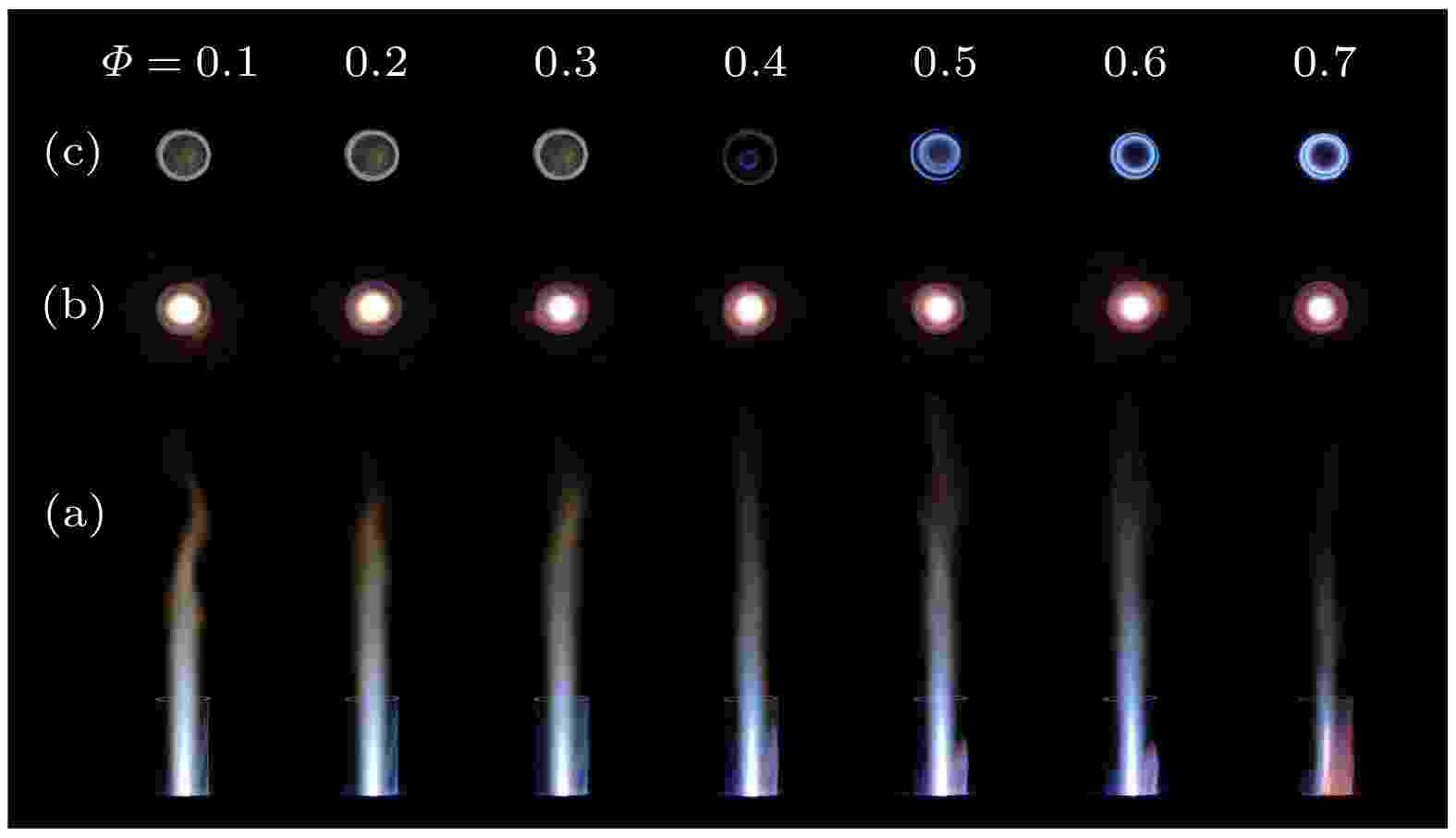
2023, 72 (15): 155201.
doi:10.7498/aps.72.20230676
Abstract +
In this work, we carry out the experiments on an atmospheric-pressure premixed methane and air microwave plasma discharge combustion with premixed methane and air to study the morphology, the spatial distribution of species, and the temperature characteristics for various microwave power values and methane-to-air equivalent ratios (Φ) at a series of measurement positions. The experimental results show that the equivalent ratio of 0.4 corresponds to the limit value for lean-combustion of premixed methane and air. And forΦ< 0.4, the discharge flame is mainly characterized by the combustion induced by premixed methane and air microwave plasma discharge, while, forΦ≥ 0.4, the discharge flame is constricted into filaments radially, and the natural combustion occurs in the region of low reduced electric strength and the combustion induced by plasma discharge in the region of high reduced electric strength, which affect each other. The variations of emission intensity of OH (A-X) band, NH (A-X) band and CN (B-X) band with the measuring position and the equivalent ratioΦare measured by using optical emission spectrometry (OES). It is found that the discharge combustion occurs in near afterglow and the combustion in far afterglow. And the vibrational temperature and the rotational temperature of the plasma discharge combustion are determined by analyzing the emission bands of CN(B-X) and the variations of both vibrational and rotational temperatures with equivalent ratio, exhibiting very different varying tendencies for cases ofΦ< 0.4 andΦ≥ 0.4, respectively. Finally, the reaction pathway and mechanism are discussed on the basis of the comparative analyses of the emission spectra of CH4diffusion combustion flame, premixed methane and nitrogen microwave plasma discharge, and premixed methane and air microwave plasma discharge combustion.
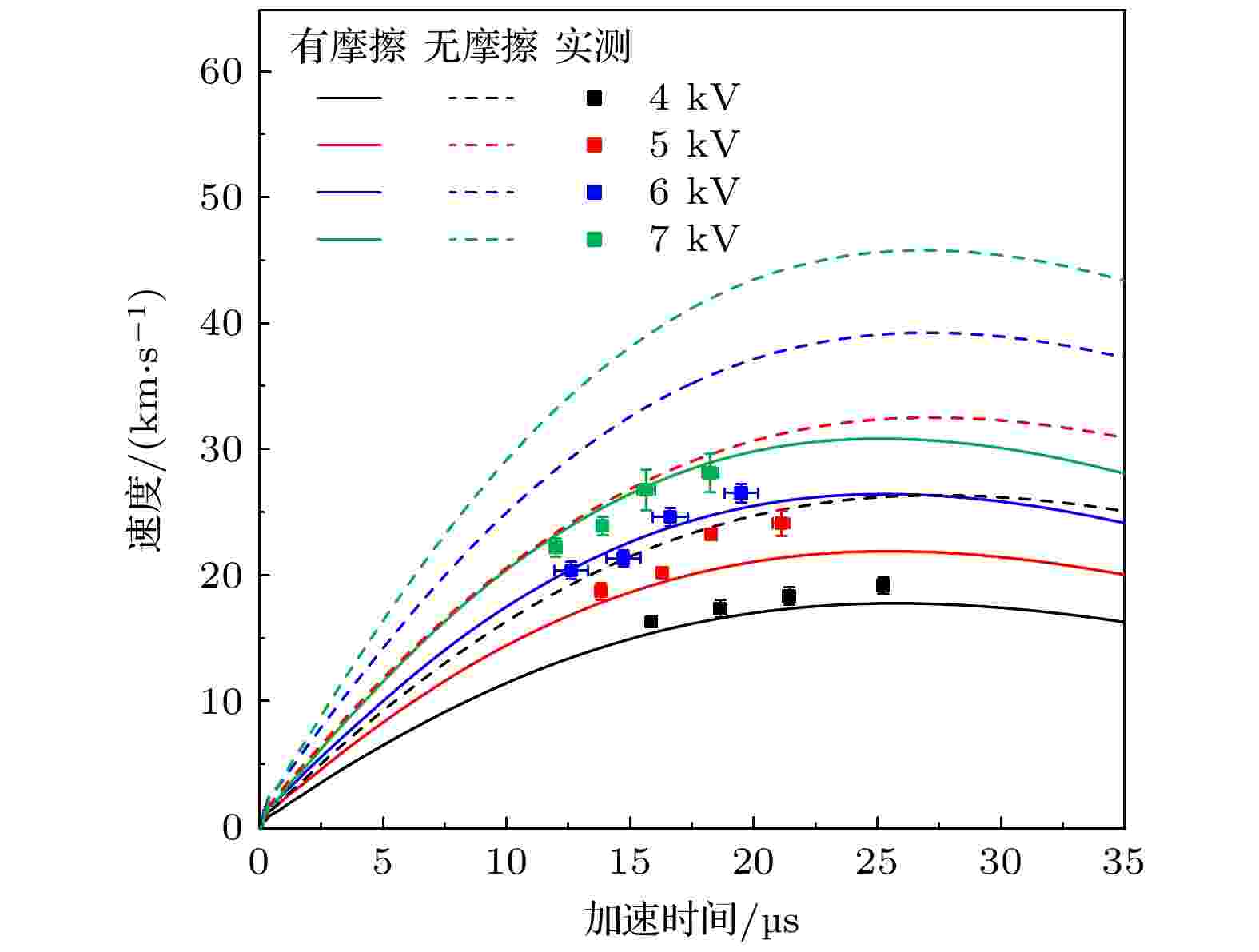
2023, 72 (15): 155202.
doi:10.7498/aps.72.20230463
Abstract +
Snowplow model is the main method to describe the acceleration process of coaxial plasma gun in the pre-fill mode, which can directly give the analytical expression of plasma velocity versus time. So it has become an important reference in designing the device structures satisfying the requirements for different applications. Through measuring the current, magnetic and optical signals, the characteristics of current during the discharge and the motion of plasmoid are investigated. The variation of discharge current with time is close to the damping sine curve, which is an underdamping solution of RLC equivalent discharge circuit. The measured current in lieu of the sine one is used to calculate the theoretical velocity so as to eliminate the error of magnetic pressure. The variation of plasma velocity with discharge voltage and chamber pressure are consistent with those obtained by solving the equation of plasma motion under snow plough model, but the acceleration process is another story. At the initial stage of the discharge, owing to the low sweep efficiency, the plasma is accelerated to a higher velocity than the predicted one, the increase of voltage and the decrease of pressure further enhance the effect. With the extension of the acceleration distance, owing to the friction resistance between plasma and electrodes, the acceleration slows down and the velocity starts to fall below the predicated value, the saturation of plasma velocity at the nozzle is found. The friction resistance term is added to the equation of plasma motion. Compared with the deviation range of 26.8%–53.6% of the existing model, the differences between the theoretical speed and the measured speed under different voltages and pressures are in a range of 3.1%–8.4% after adding the friction resistance term into the equation of plasma motion. The optimization of snow plow model greatly improves the accuracy of velocity prediction, which can provide an effective reference for designing device structure and calculating energy efficiency.
CONDENSED MATTER: STRUCTURAL, MECHANICAL, AND THERMAL PROPERTIES

2023, 72 (15): 156201.
doi:10.7498/aps.72.20230606
Abstract +
Fused silica optical element is the core component of the inertial confinement nuclear fusion ignition device. Due to the requirement of ignition conditions of the device for high power laser, the damage to fused silica optical element under strong laser is the key to restricting the operation of the ignition device. Therefore, the study of the surface damage of fused silica irradiated by laser is crucial to the development of the ignition device for inertial confinement nuclear fusion. In this paper, large-scale non-equilibrium molecular dynamics simulation method and micro-structure analysis technology suitable for dynamic process are proposed to study the damage process of fused silica surface under laser loading. Based on the theoretical study of high-temperature plasma fireball model, the damage of high-temperature fused silica plasma ball to surface is simulated. By tracking the local structure, temperature distribution and surface morphology, the factors affecting the surface damage of fused silica are analyzed. Our research results show that the size, distance from the surface, and temperature of high-temperature fused silica balls have important effects on the surface damage. We find that there are two different damage modes under the combined effect of the above factors. One is related to a rapid damage process, generating U-shaped voids and no further obvious damages after the surface spraying, and the other is dependent of a slow damage process: continuously expanding and resulting in a larger damage area. The surface morphologies formed by these two damage modes are consistent with the two typical damage morphologies observed in the experiments. This research can provide a guidance for understanding the complex damage process in fused silica under laser irradiation.
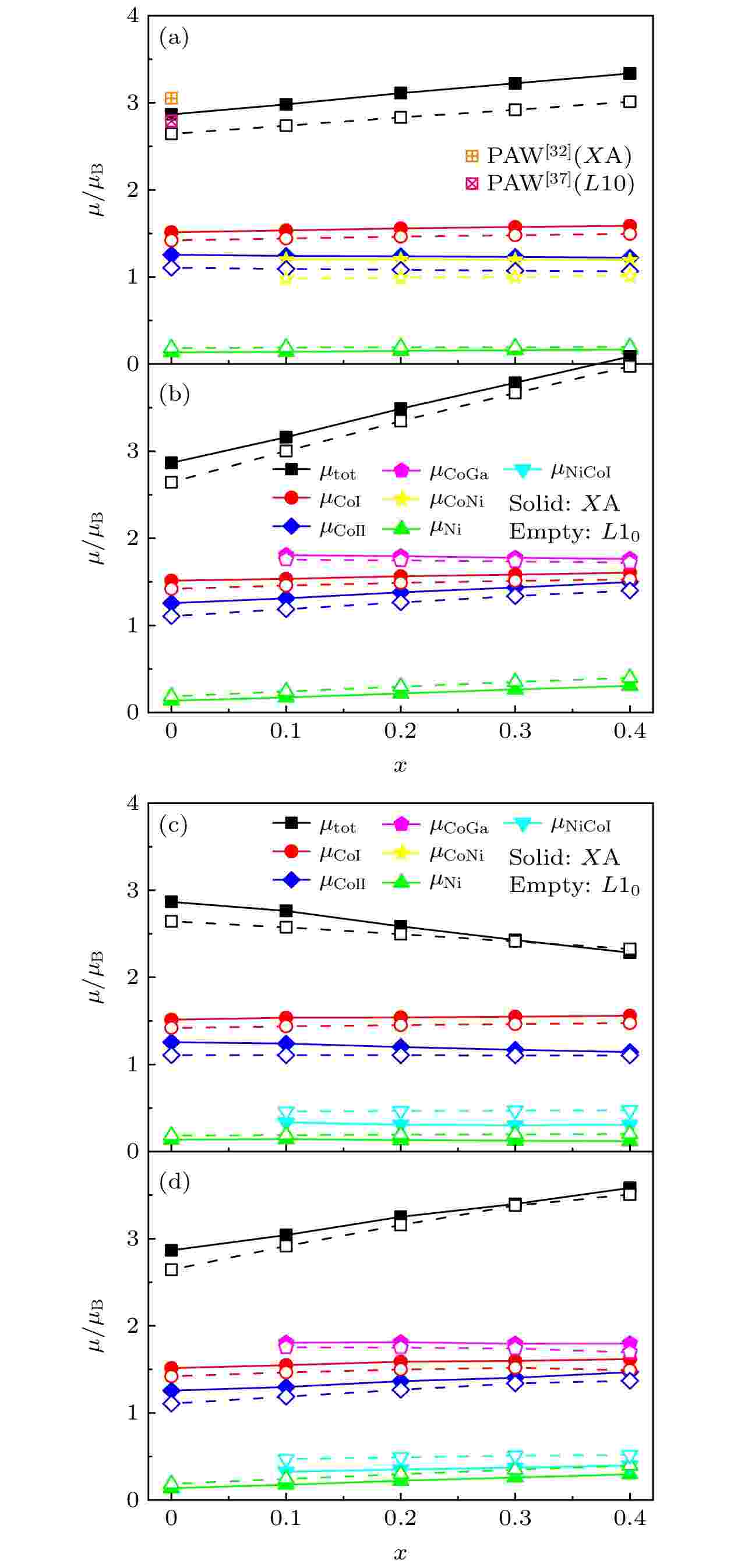
2023, 72 (15): 156301.
doi:10.7498/aps.72.20230626
Abstract +
Using the first-principles exact muffin-tin orbital method combined with the coherent potential approximation, the crystal structure and site occupation, martensitic transformation, magnetic moment and elastic constant for each of Co2+xNi1–xGa, Co2+xNiGa1–x, Co2–xNi1+xGa and Co2Ni1+xGa1–x(0 ≤x≤ 0.4) alloys with Co and Ni excess at 0 K are systematically investigated. It is shown that most of the austenitic phases of the alloys haveXA stable structure, and the excess Co and Ni atoms occupy the insufficient atomic positions, and it is inversely occupied only when Ni replaces Ga. With the increase ofx, the total electron energy ofL10relative toXA of only two Ga-insufficient alloys gradually decreases, for the former, the tetragonal shear elastic constant gradually increases, but for the latter, it gradually decreases. It is indicated that the martensitic transformation is promoted by the substitution of both Co and Ni for Ga in the energy and mechanics, and the martensitic transformation temperature is expected to increase. The values of total magnetic moment (μtot) of theXA phase andL10phase of each alloy are mainly contributed by Co atoms, but onlya relatively small portion by Ni atoms. And the values ofμtotof two phases in the four alloys have the same relationship withx, and the difference between them with the same compositions is not more than about 0.32μB. The analyses of electronic structure calculations show that the distributions of spin-down electronic density of states of Co and Ni atoms near the Fermi energy level have contributed significantly to the stability ofL10relative to theXA phase, which is attributed to the Jahn-Teller effect. The above results are expected to provide a theoretical reference for the optimal design of the structure and properties of Co2NiGa-based ternary alloys.
CONDENSED MATTER: ELECTRONIC STRUCTURE, ELECTRICAL, MAGNETIC, AND OPTICAL PROPERTIES

2023, 72 (15): 157201.
doi:10.7498/aps.72.20230527
Abstract +
A high-performance silicon-based terahertz modulator is one of the key devices for building an ultrawideband terahertz-fiber hybrid communication system. In this paper, an ultrawideband terahertz modulator with large modulation depth based on a chalcogenide/graphene/silicon (MAPbI3/Graphene/Si) composite structure driven by near-infrared light (NIR) is proposed. The experimental results show that the graphene thin film and the chalcogenide hole transport layer can effectively promote the interfacial charge separation, increase the carrier complex lifetime, significantly enhance the surface conductivity of the device, further modulate the terahertz wave transmission amplitude, and realize the function of the light-controlled terahertz wave modulator under the NIR light drive. The terahertz transmission characteristics of the device are characterized by an 808 nm NIR modulation excitation source, and a large modulation depth of up to 88.3% is achieved in an ultra-wide frequency range of 0.2–2.5 THz and a low power density of 6.1 mW/mm2driven by NIR light, which is much higher than that of the bare silicon substrate (14.0%), with the significant advantages of high sensitivity, broadband, and large modulation depth. The corresponding semi-analytical device model is established and the experimental results are verified by simulation. The proposed MAPbI3/Graphene composite thin film is effective in enhancing the silicon-based modulator performance and provides a new strategy for the future integration of silicon-based terahertz modulators in NIR terahertz-fiber hybrid communication systems.
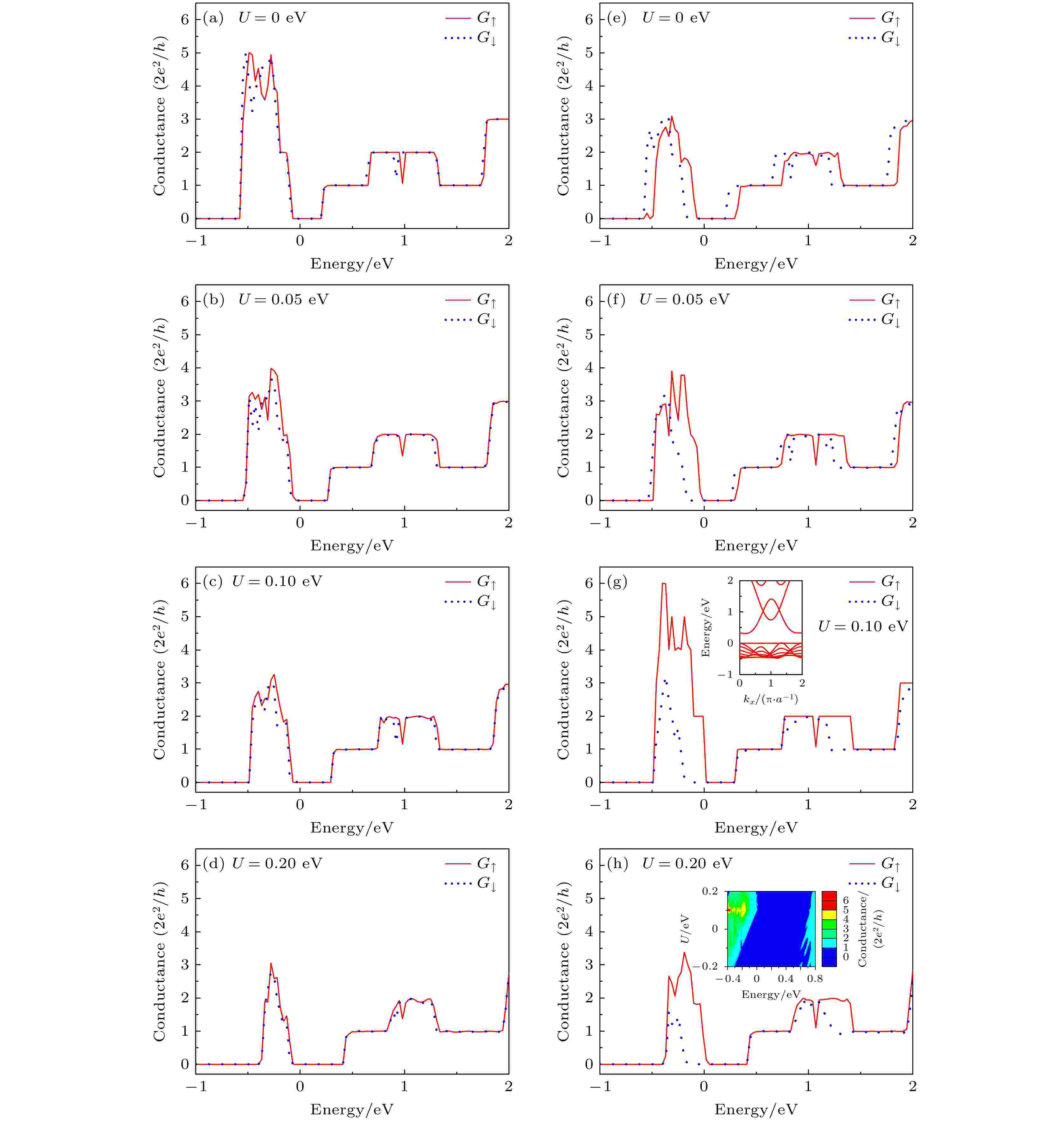
EDITOR'S SUGGESTION
2023, 72 (15): 157202.
doi:10.7498/aps.72.20230483
Abstract +
Spintronics is a new type of electronics based on electron spin rather than charge as the information carrier, which can be stored and calculated by regulating and manipulating the spin. The discovery and application of the giant magnetoresistance effect opens the door to the application of electron spin properties. Realizing on-demand control of spin degree of freedom for spin-based devices is essential. The two-dimensional novel material, monolayer transition metal dichalcogenide (TMD) (MoS2is a typical example from the family of TMD materials), has become an excellent platform for studying spintronics due to its novel physical properties, such as direct band gap and strong spin-orbit coupling. Obtaining high spin polarization and achieving controllability of degrees of freedom are fundamental problems in spintronics. In this paper, we construct the monolayer zigzag MoS2nanoribbon quantum structure of electrically controlled ferromagnetic electrode to solve this problem. Based on the non-equilibrium Green’s function method, the regulation of the magnetic exchange field and electrostatic barrier on the spin transport in parallel configuration and anti-parallel configuration are studied. It is found that in the parallel structure, spin transport is obviously related to the magnetic exchange field, and 100% spin filtering can occur near the Fermi energy level to obtain pure spin current. When an additional electric field is applied to the middle region, the spin filtering effect is more significant. Therefore, the spin switching effect can be achieved by regulating the incident energy. In addition, it is also found that within a specific energy range, electrons in the parallel configuration are excited to participate in transport, while electrons in the anti-parallel structure are significantly inhibited. Consequently, a noticeable giant magnetoresistance effect can be obtained in this quantum structure. Moreover, it can be seen that the magnetic exchange field strength can effectively modulate the giant magnetoresistance effect. These results provide valuable theoretical references for the development of giant magnetoresistance devices and spin filters based on monolayer zigzag MoS2nanoribbons.
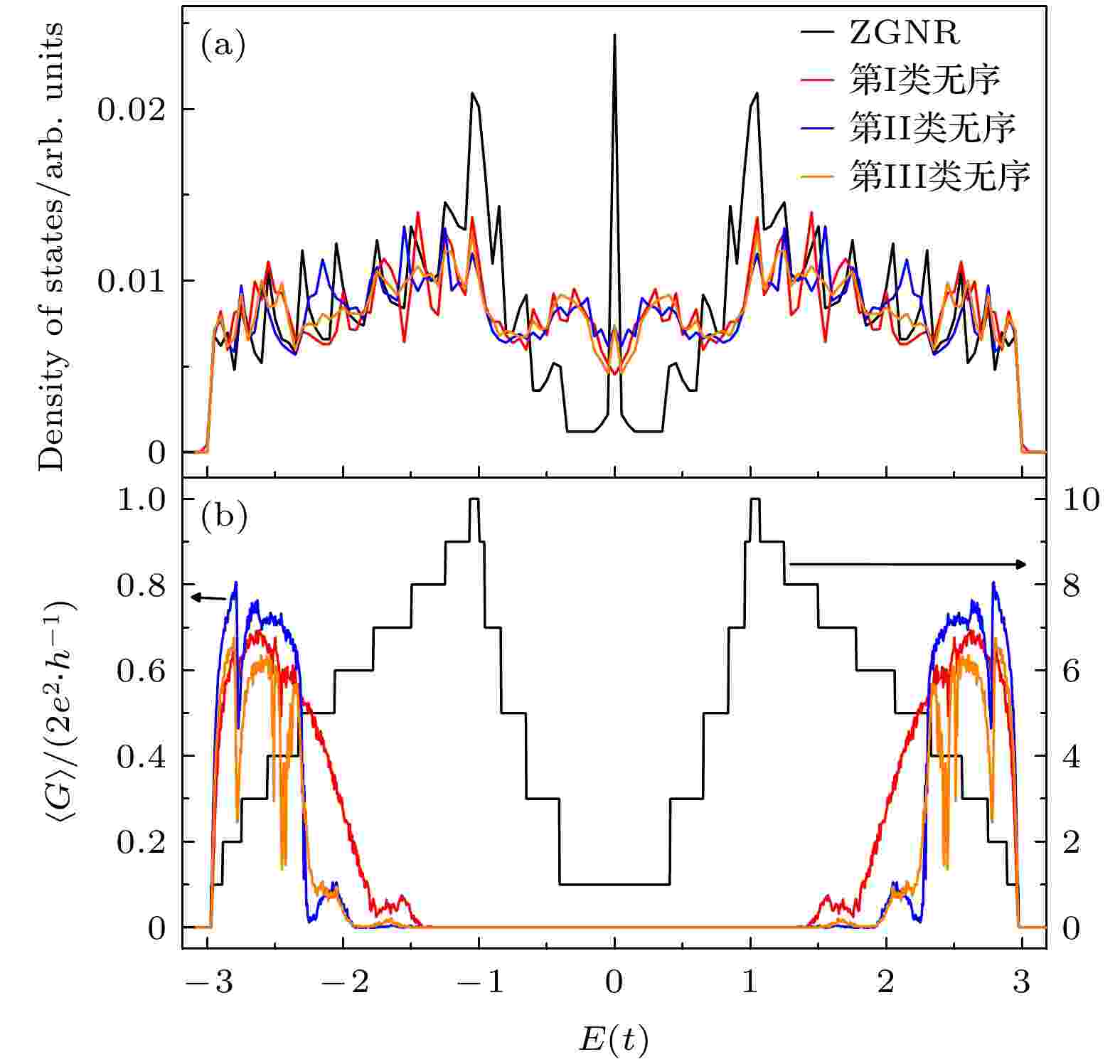
EDITOR'S SUGGESTION
2023, 72 (15): 157301.
doi:10.7498/aps.72.20230502
Abstract +
Bandgap engineering in graphene has been a hot topic in condensed matter physics. Although several line defects have been experimentally reported in graphene, the relationship between the bandgap engineering and the line defects has not yet been discussed. In this work, by combining the Green’s function method with the Landauer-Büttiker formula, we study theoretically the electron transport along disordered ZGNRs through taking into account three types of line defects which arise from random distribution of 4-8 rings. Our results show that although there exist electronic states around the Fermi energy of the disordered ZGNRs with randomly distributed line defects, all these electronic states are localized and a transmission gap appears around the Fermi energy. This localization phenomenon originates from the structural disorder induced by the randomly distributed line defects. To demonstrate the robustness of transmission gaps, we further calculate the conductance values of disordered ZGNR with different insertion probabilities and widths, finding that the size of transmission gap strongly depends upon the types of disorder, disorder degree, and width. When the disorder degree of line defects is low or the width of the nanoribbon is narrow, there is a notable difference in the size of the transmission gaps among the three types of disordered ZGNRs. As the width or disorder degree increases, the transmission gap size tends to be consistent. Like armchair ZGNRs, the transmission gap size decreases with the increase of width or disorder of ZGNR. Nonetheless, the openings of the transmission gaps in three types of disordered ZGNRs remain robust, regardless of variations in degree of disorder or width. These results are helpful in designing line-defect based nanodevices.
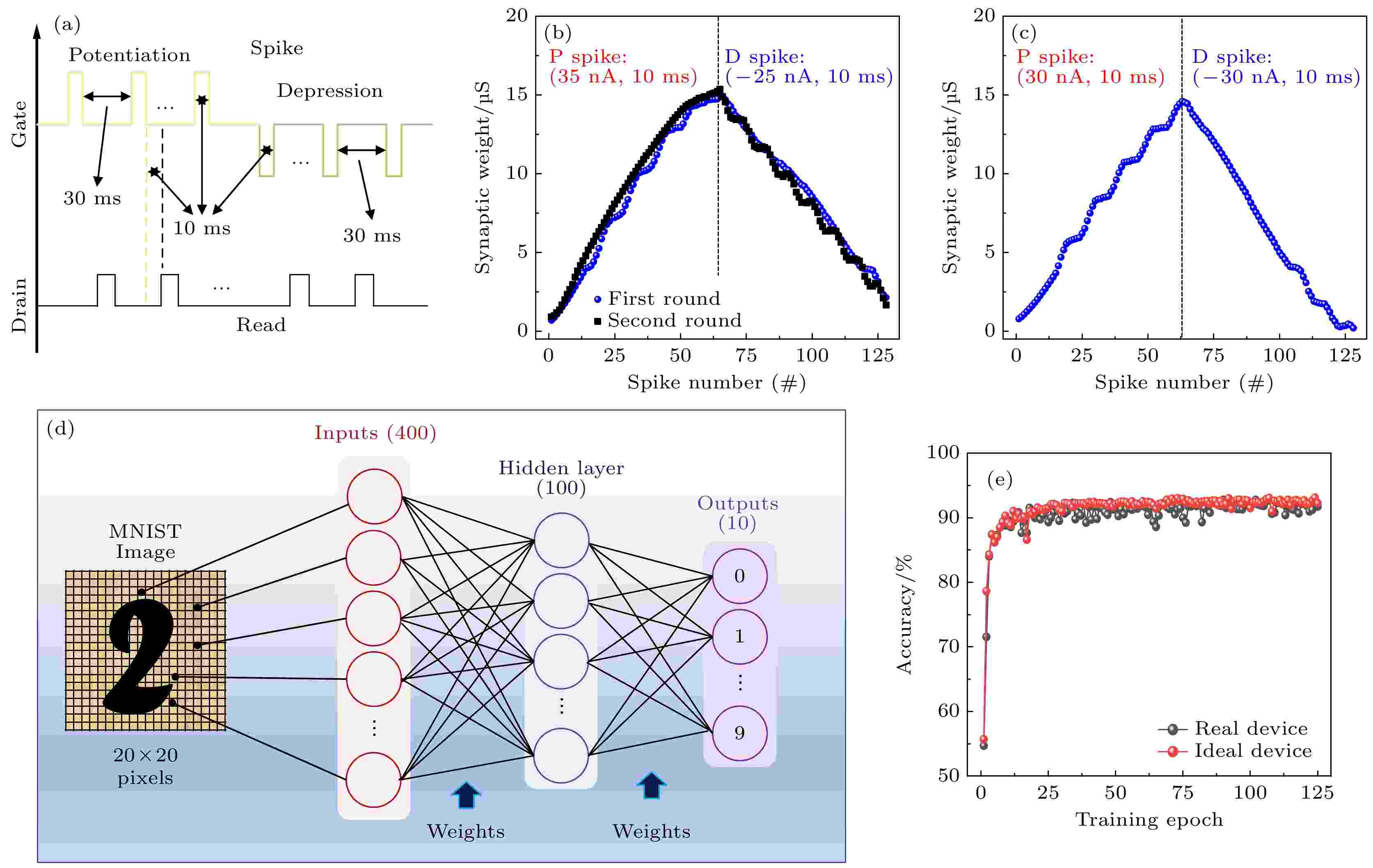
EDITOR'S SUGGESTION
2023, 72 (15): 157302.
doi:10.7498/aps.72.20230411
Abstract +
In recent years, the study of neuromorphic devices has received extensive attention. It is becoming an important branch of the development of artificial intelligence technology. At the same time, natural biomaterials have several priorities, such as biodegradability, good biocompatibility, and non-toxicity, and have important value in novel portable intelligent systems. The egg shell membrane (ESM) is a fiber scaffold composed of highly crosslinked collagen, glycoprotein and cysteine-rich eggshell membrane proteins. It has porous morphology, thermal stability, mechanical strength, etc. Therefore, these protein-based fiber membranes have several potential applications, including nanocatalysts, microbial fuel cells, and adsorption of toxic dyes. This study adopts ESM as electrolyte, exhibiting extremely high proton conductivity of about 6.4×10–3S/cm and extremely high electric-double-layer (EDL) capacitance of about 2.8 µF/cm2at room temperature. Thus, it has extremely strong interfacial EDL electrostatic modulation capability. Then, indium tin oxide EDL transistor is fabricated by using a single step masking processing and magnetron sputtering deposition technology. The device exhibits typical n-type output curves and transfer curves at low operating voltage. In addition, transfer curves are scanned twice. It is observed that the curves approach to each other quite well, indicating the good stabilities. Owing to the extremely strong proton gating effects, the device exhibits excellent electrical performances. Specifically, ON/OFF ratio, mobility and sub-threshold swing are estimated to be about 2.5×106, about 3.2 cm2/(V·s), and about 213 mV/dec, respectively. With the unique interfacial EDL modulation activities of ESM, the transistor can mimic some important synaptic plasticity behaviors, such as excitatory postsynaptic current (EPSC) and paired pulse facilitation (PPF). With the increase of pre-synaptic spike amplitude, the EPSC value increases correspondingly. With the increase of pre-synaptic spike frequency, the EPSC grain increases, indicating the potentials in high-pass synaptic filtering. By loading 64 potentiation spikes and 64 depression spikes, multi-level synaptic weight can be updated, demonstrating potentiation activity and depression activity. Again, with the same potentiation spikes and depression spikes, synaptic weight value curves approach to each other quite well, indicating that the present ESM gated oxide neuromorphic transistor has good stability. Then, an artificial neural network is adopted to perform supervised learning with Modified National Institute of Standards and Technology (MNIST) database. For simulation, a two-layer multilayer perceptron (MLP) neural network with 400 input neurons, 100 hidden neurons and 10 output neurons is adopted. The best recognition accuracy is as high as 92.59%. The proposed ESM gated oxide neuromorphic transistors have certain potentials in low-cost biodegradable neuromorphic systems.
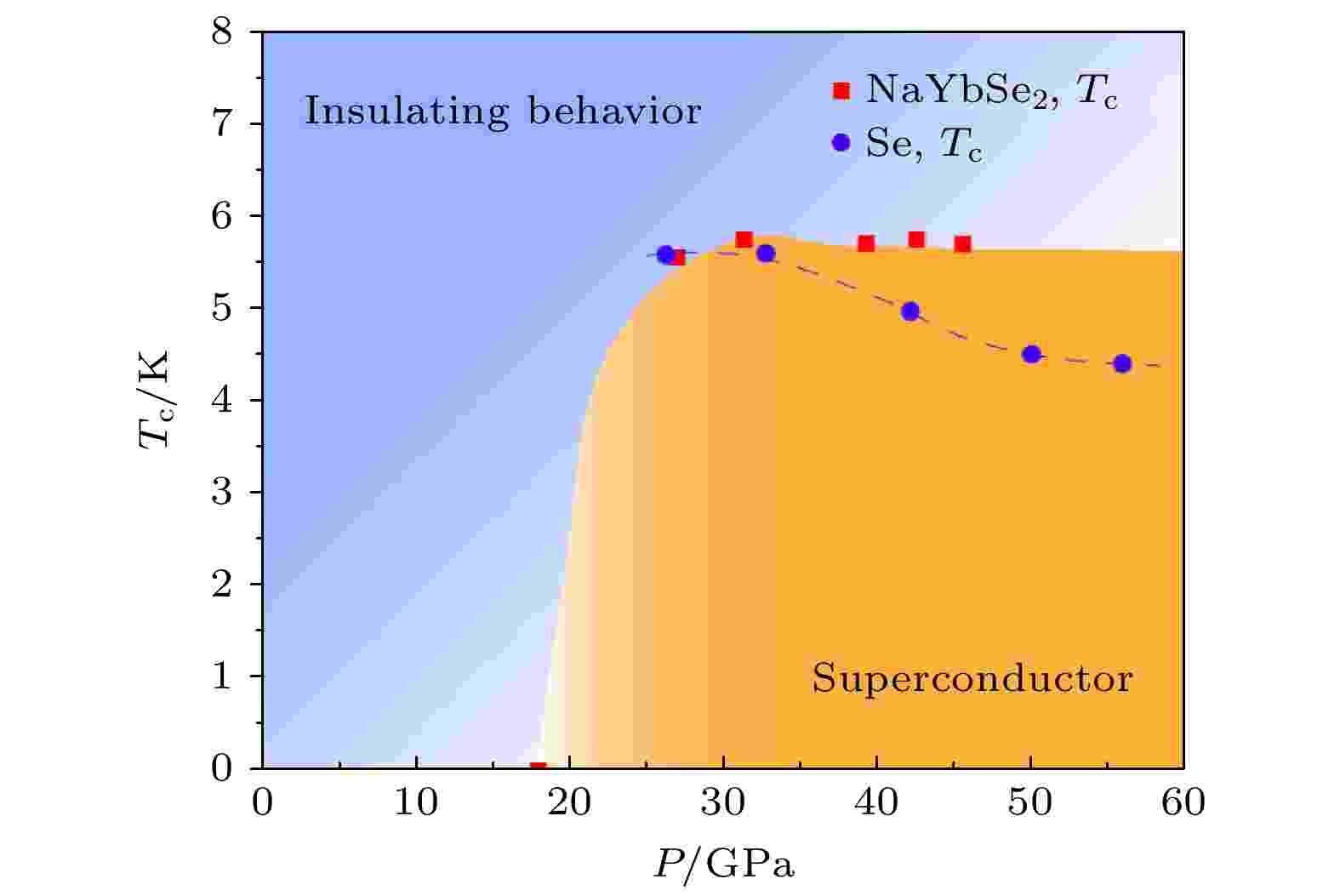
EDITOR'S SUGGESTION
2023, 72 (15): 157401.
doi:10.7498/aps.72.20230730
Abstract +
Quantum spin liquid is an exotic state without magnetic order down to zero-temperature due to spin frustration, which is closely related to high temperature superconductivity. Therefore, an important issue arises whether the quantum spin liquid can be adjusted into a superconductor, even high-Tcsuperconductor, by using pressure or chemical doping. Rear-earth chalcogenides NaYbCh2(Ch = O, S, Se), consisting of planar triangular lattice, exhibit no long-range magnetic order down to the lowest measured temperatures in specific heat, nuclear magnetic resonance, and neutron scattering, and are considered as a quantum spin liquid candidate. Here we investigate the electrical transport properties of NaYbCh2(Ch = O, S, Se) under high pressures. For NaYbSe2, zero-resistance behavior is observed at 26.9 GPa, showing that the superconductivity comes into being. The superconducting transition temperature (Tc) is around 5.6 K at 26.9 GPa and robust against pressure till 45 GPa. The phase diagram ofTcversus pressure for NaYbSe2is constructed. For NaYbS2, the room temperature resistance decreases from the order of 1011Ω at 10 GPa to 10 Ω at 67 GPa. However, neither superconductivity nor insulator-metal transition is observed. Additionally, the NaYbO2keeps insulating and the resistance is too large to be detected in a pressure range of 0–60 GPa.
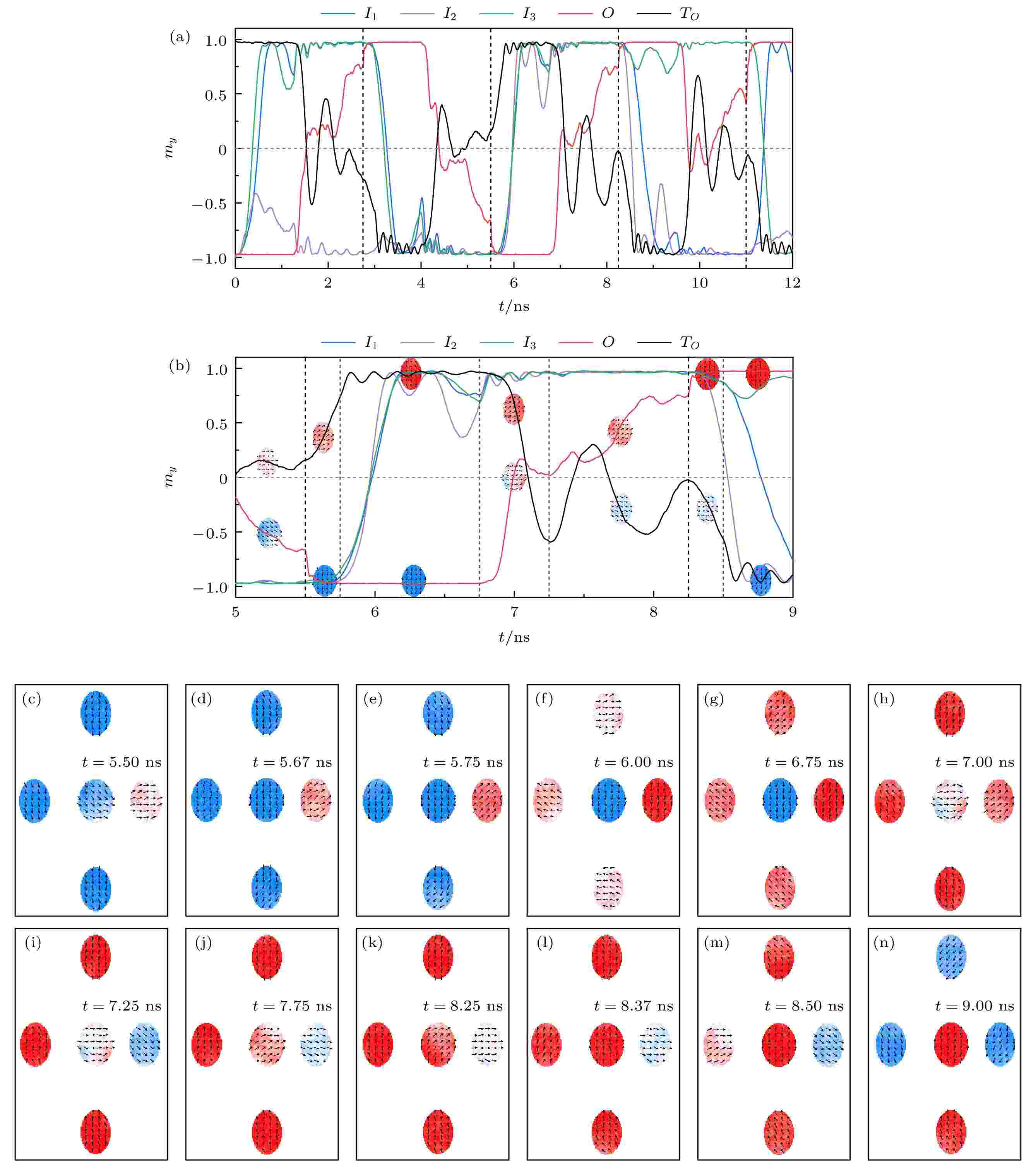
2023, 72 (15): 157501.
doi:10.7498/aps.72.20230866
Abstract +
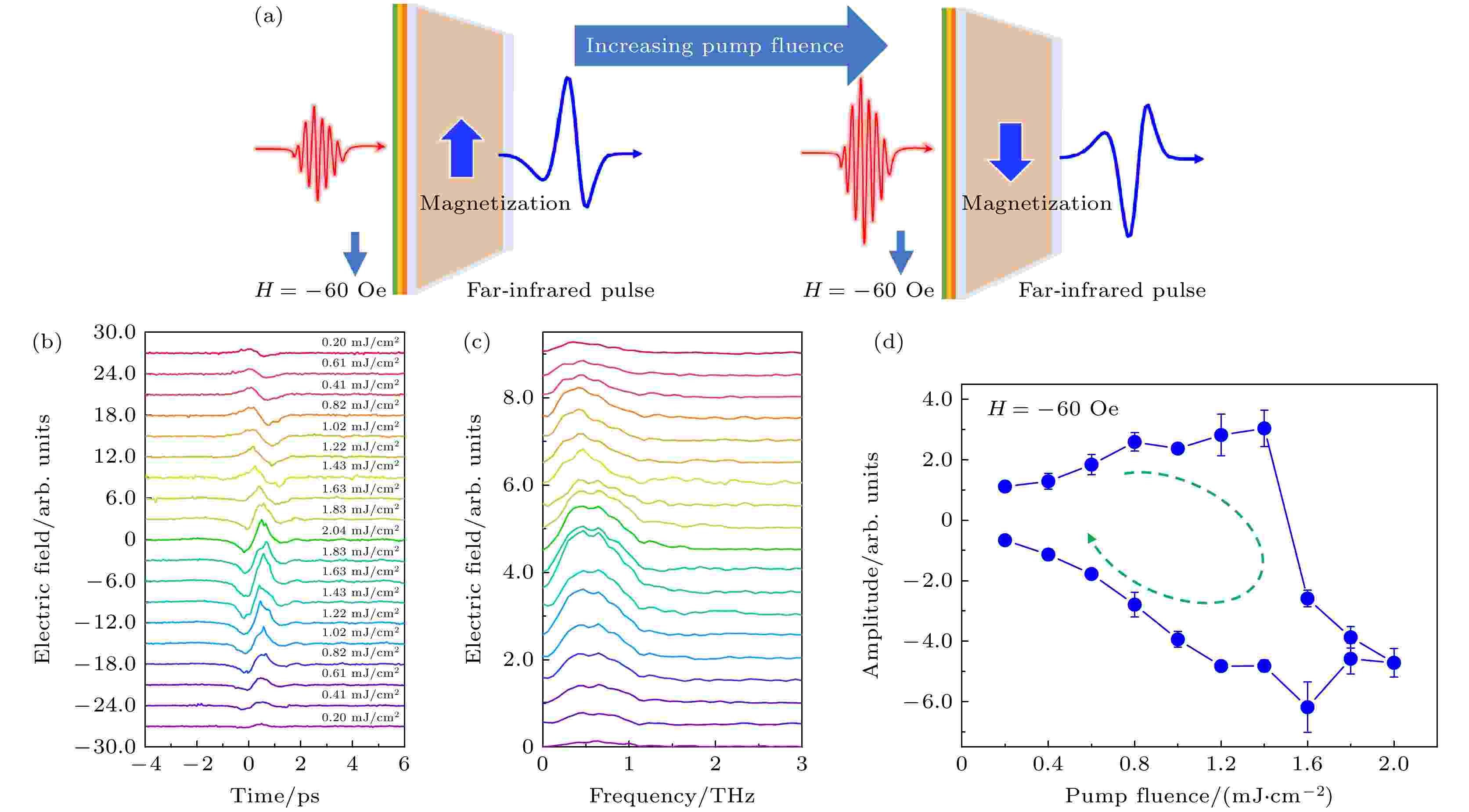
EDITOR'S SUGGESTION
2023, 72 (15): 157801.
doi:10.7498/aps.72.20230543
Abstract +
Under illumination of a femtosecond laser pulse on the Pt/CoFe/Ta trilayer heterostructure, an impulsive spin current can be generated in the ferromagnetic layer due to the ultrafast demagnetization. The spin current is super-diffusively transported and injected into the neighboring heavy metal layers, and is converted into the transversal charge current due to the spin-orbit coupling, which is named inverse spin Hall effect. The transient charge current on a time scale of sub-picosecond gives rise to the electromagnetic radiation in the far-infrared range to the free space. In this work, we demonstrate two kinds of experiments to investigate the modulation of far-infrared emission by photo-thermal effect, which is due to the thermal energy deposed by light pulses on a short timescales. First, the amplitude of the emitted far-infrared pulse as a function of an applied magnetic field is measured, which shows a far-infrared hysteresis behavior. The coercive field of the sample obtained by far-infrared hysteresis is smaller than that obtained by theM-Hhysteresis through vibrating sample magnetometer. In addition, the coercive field decreases with pump laser fluence increasing. Second, the control of spin polarization on an ultrafast timescale in the presence of a small magnetic field applied oppositely to that of the magnetization of the ferromagnetic sample. The amplitude of far-infrared time-domain signal reaches a maximum value at a pump fluence of 1.43 mJ/cm2. For the pump fluence larger than 1.43 mJ/cm2, the far-infrared pulse experiences a phase reversal. After the reversal, a decrease of the laser pump fluence cannot restore the original phase of the far-infrared pulse. The above two experimental results not only elucidate the photothermal effect of femtosecond laser pulses, but also provide a new method for controlling the far-infrared radiation pulses based on ultrafast spintronics. These results demonstrate that far-infrared emission spectroscopy can be used as an ultrafast optical method to investigate magnetic properties, such as the coercive field and anisotropy field of the samples.
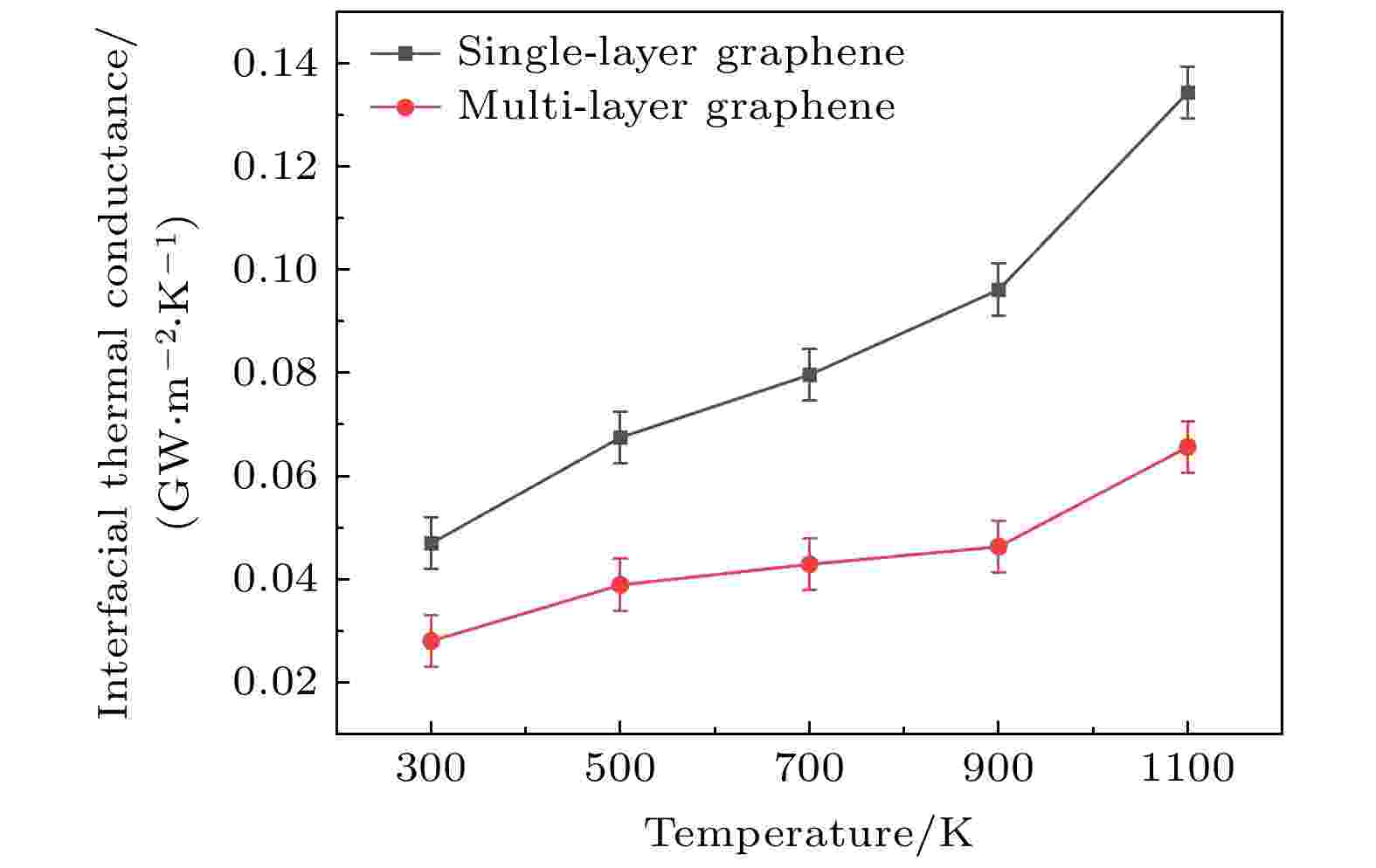
2023, 72 (15): 157901.
doi:10.7498/aps.72.20230537
Abstract +
In order to study the thermal transport properties of heterogeneous gallium nitride/graphene/silicon carbide interface, the effects of temperature, size and vacancy defects on the thermal conductance of the interface are investigated by non-equilibrium molecular dynamics method, and the effects of changes of phonon state density and phonon participation rate on the thermal conductance of the interface are further analyzed. The results show that the thermal conductance of the interface increases with temperature increasing. The analysis shows that as temperature rises, the lattice vibration intensity, the density of low frequency phonon states, and the number of phonons involved in heat transport all increase. The change of thermal conductance at the interface of single-layer graphene is higher than that of multi-layer graphene. When the structural size of the heat transport direction is changed and the number of layers of gallium nitride and silicon carbide are changed at the same time, the thermal conductance at the interface does not change significantly, and the phonon scattering of the thermal transport at the interface is almost unaffected. However, as the number of graphene interlayers increases from the first layer to the fifth layer, the interface thermal conductance first decreases and then slowly increases. Because of the fourth layer, the participation rate of low frequency phonons decreases, more phonons are localized, and the number of phonons that do not participate in heat transfer increases, and the interfacial thermal conductance reaches a minimum value of 0.024 GW/(m2·K). As the vacancy defect concentration increases, the interfacial thermal conductance first increases gradually and then decreases. The difference is that when the concentration of single vacancy defects is 10%, the interface thermal conductance reaches a maximum value of 0.063 GW/(m2·K). When the concentration of double vacancy defects is 12%, the interfacial thermal conductance reaches a maximum value of 0.065 GW/(m2·K). The analysis shows that more phonons enter into the delocalisation from the local region and more phonons participate in the heat transfer, leading to the increase of the interface thermal conductance. The results are useful in adjusting the thermal transport performance of GaN devices and provide a theoretical basis for designing the devices with heterogeneous interfaces.
INTERDISCIPLINARY PHYSICS AND RELATED AREAS OF SCIENCE AND TECHNOLOGY

2023, 72 (15): 158301.
doi:10.7498/aps.72.20230118
Abstract +
As one of the regulators of cationic concentration in cells, potassium channels play an important role in the depolarization and repolarization of nerve cell. KcsA (K+conduction and selectivity architecture) channel is simple and has the commonness of potassium ion channel, which is often used as a template for potassium channel research. In this paper, Brownian dynamics (BD) method is used to simulate the electrical characteristics of the actual KcsA potassium channel systematically. The potential mean force (PMF) of ions in the channel under electrostatic field, the current-voltage characteristic curve of symmetric solution and asymmetric solution, the ion concentration distribution curve in the axial direction of the channel, and the conduction-concentration curve are obtained. The results show that the selectivity filter region of KcsA potassium channel blocks the passage of Cl–basically, showing a special selection characteristic of the passage of K+, that its current-voltage curve presents a basically linear distribution, and that the conductivity-concentration curve presents a trend of first increasing and then flattening. The basic characteristic is consistent with the experimental phenomenon. In addition, the influence of the THz field on the channel K+current is also simulated and analyzed. Compared with applying only the same amplitude electrostatic field, the selected terahertz field of 0.6 THz, 1.2 THz, and 5 THz can reduce the PMF by affecting the interaction potential energy between ion pairs, thereby increasing the K+current. The research in this paper not only deepens the understanding of the regularity of KcsA potassium ion channels, but also provides a new idea for studying other types of ion channels and the influence of terahertz field on the characteristics of ion channels.
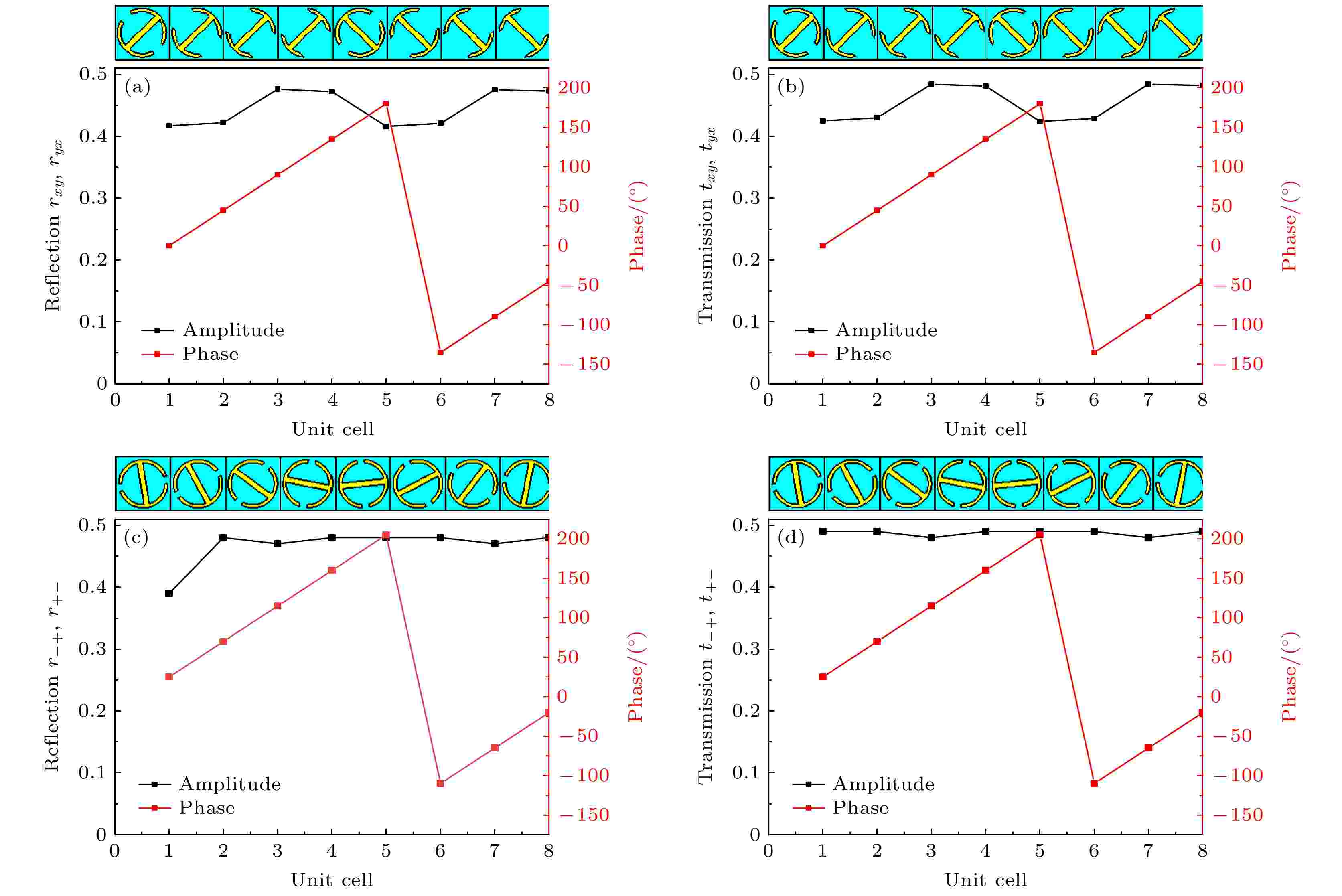
2023, 72 (15): 158701.
doi:10.7498/aps.72.20230471
Abstract +
In this paper, we propose a dual-polarization ultra-wideband metasurface with half-reflection and half-transmission based on a double-split-ring (DSR) structure operating in a terahertz (THz) frequency range. The designed metasurface can simultaneously control the circularly polarized (CP) wave and linearly polarized (LP) wave in reflection mode and transmission mode, covering an extensive THz frequency range. The unit-cell architecture of the metasurface consists of a periodic arrangement of the DSR structure made of metal, which is affixed to an ultra-thin dielectric substrate. By manipulating the size and rotation direction of the DSR structure, we achieve full phase coverage of 0–2π of the orthogonally polarized LP wave and CP wave across a frequency span of 0.3–1.2 THz, encompassing transmission and reflection scenarios. The relative bandwidths of the corresponding orthogonal LP wave and CP wave with an average amplitude of 0.45 reach 86% and 120%, respectively. Specifically, through numerical simulations, we demonstrate that the designed metasurface has the ability to achieve THz beam deflection and vortex beam generation while reflecting and transmitting LP wave and CP wave. The proposed dual-polarization ultra-wideband metasurface holds great promise for various applications in the terahertz frequency range. These findings pave the way for the development of flexible and versatile THz devices with expanded functionality, thereby opening up new possibilities for wavefront manipulation in metasurfaces.
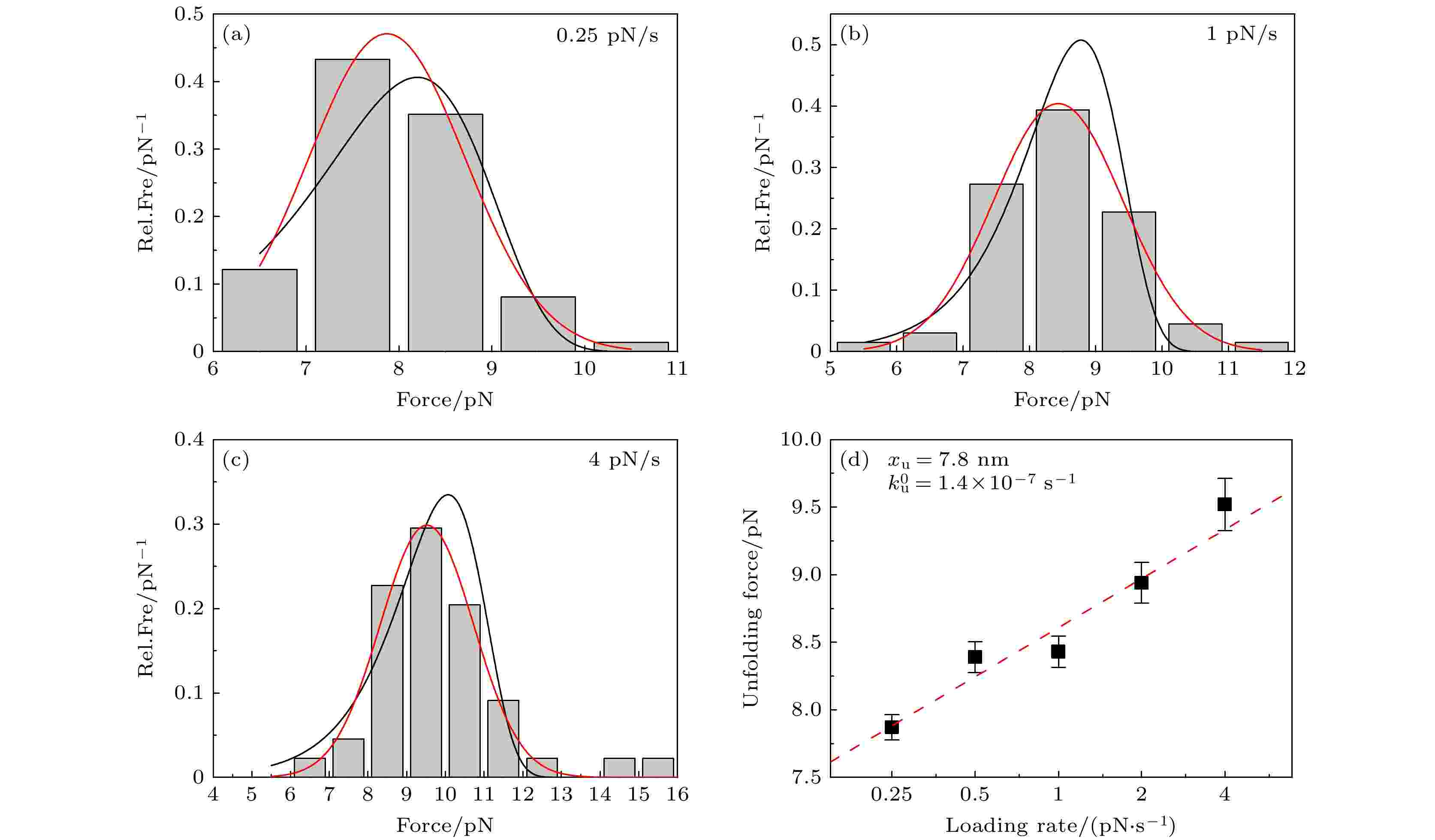
EDITOR'S SUGGESTION
2023, 72 (15): 158702.
doi:10.7498/aps.72.20230533
Abstract +
There are significant differences in mechanical stability and unfolding dynamics among proteins with different structural compositions. Compared with proteins with β-sheets and subjected to shearing forces, proteins that are composed entirely of α-helices often undergo rapid unfolding under low stretching forces, thus requiring quantitative studies by using experimental tools that can precisely control forces on a pico-Newton scale. Magnetic tweezers with intrinsic force-control capability and great stability for long-time continuous measurement are suitable to measure force-induced conformation transitions of protein subjected to low forces of several pico-Newton. Acyl-CoA binding protein (ACBP) is a model protein used to study the folding/unfolding kinetics of complete α-helices protein. It is composed of 86 amino acid residues, forming a helical bundle of four α-helices. When its N- and C-terminal are stretched, the first and last α-helix are subjected to shear force in parallel. Previous biochemical studies showed that ACBP folding and unfolding in a two-state manner. In this paper, we use magnetic tweezers to stretch ACBP from its N- and C-end and obtain the distribution of the unfolding force at different loading rates ranging from 0.25 pN/s to 4 pN/s. The most probable unfolding forces are all less than 10 pN, which confirms that ACBP is not mechanically stable. At a constant loading rate, the unfolding force distribution and the most probable unfolding force as a function of loading rate have well-defined analytical formulas based on Bell’s model. Therefore, the experimental results of unfolding force can be fitted directly to obtain the important kinetic parameter of unfolding distance which is defined as the difference in extension between the native state and the transition state. Data analysis shows that ACBP has an extraordinarily long unfolding distance of 7.8 nm. Steered molecular dynamics simulations of ACBP stretching gives the transition state with N-terminal α-helix fully unfolded and C-terminal α-helix partially unfolded, which is consistent with the long unfolding distance obtained in the experiment on magnetic tweezers. According to the simulation results, the unfolding of α-helices is less cooperative than that of β-sheet structures. This characteristic makes α-helix proteins sensitive to mechanical forces, rendering them suitable as force sensors in cells. This study shows that single-molecule stretching experiment combined with molecular dynamics simulations is a reliable method to reveal the molecular mechanism of protein conformationtransitions under stretching forces.
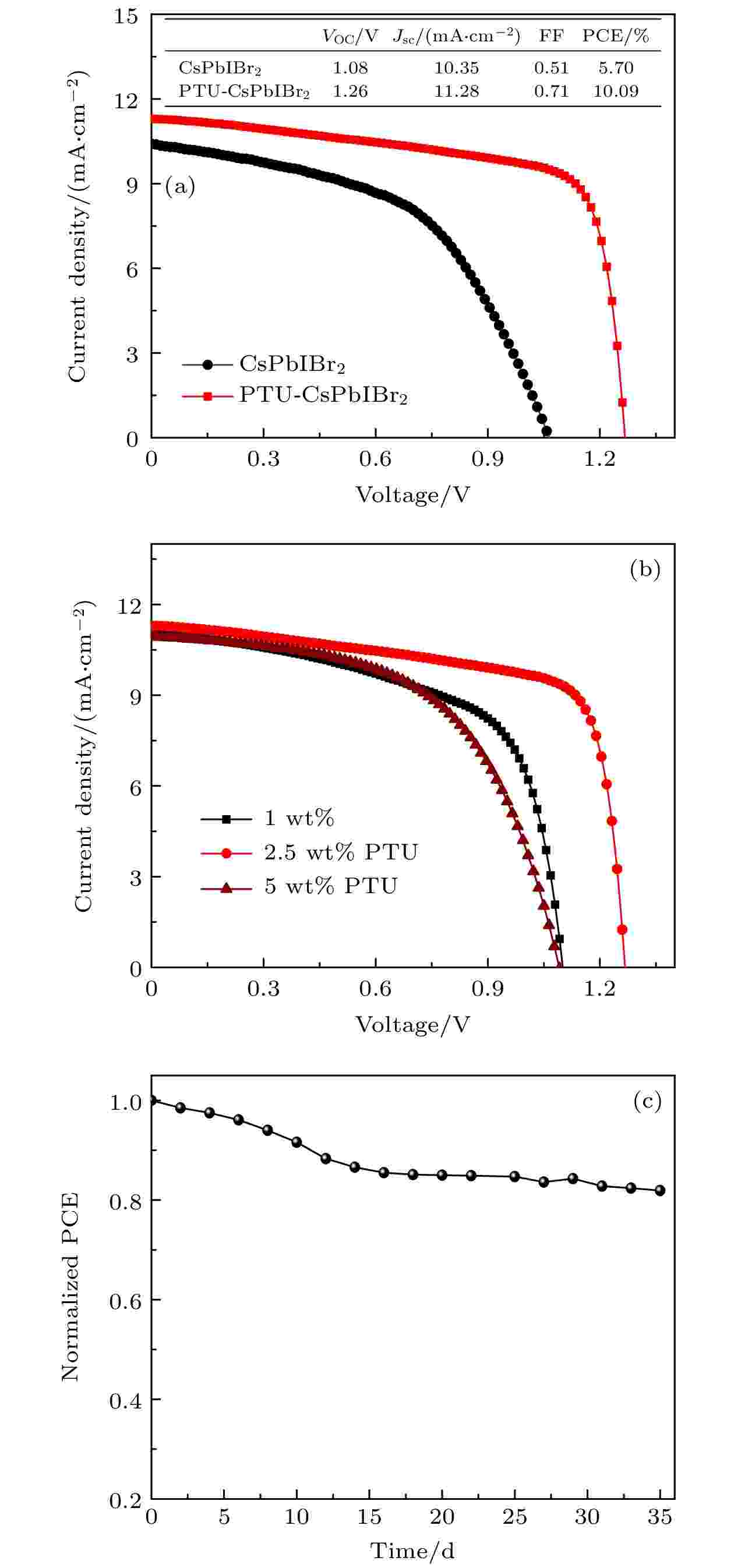
EDITOR'S SUGGESTION
2023, 72 (15): 158801.
doi:10.7498/aps.72.20230593
Abstract +
Inorganic CsPbIBr2perovskite has been considered as a promising light-absorbing material for solar cells due to its high stability and suitable bandgap. Although the remarkable improvement of CsPbIBr2PSC has been achieved, the efficiency of this cell is still lower than those of other analogues and far below its theoretical limit. This is mainly due to the serious charge recombination in the as-fabricated CsPbIBr2cells derived from the poor-quality CsPbIBr2perovskite film with a large quantity of defects and numerous grain boundaries. Therefore, fabricating high-quality CsPbIBr2perovskite film is a key factor for the further efficiency improvement of CsPbIBr2PSCs. Herein, phenylthiourea (PTU) additive is introduced into the CsPbIBr2precursor to tailor the crystallization of CsPbIBr2perovskite for fabricating high-quality CsPbIBr2perovskite. The C=S group of PTU can coordinate with PbBr2in the precursor owing to the lone-pair electrons on S and the empty orbits of Pb2+. The strong interaction between PTU and the CsPbIBr2precursor components can form PTU·Pb···Br(I) intermediate phase in the precursor upon PTU introduction. The PTU·Pb···Br(I) intermediate phase can reduce the nucleation rate of perovskite and modulate the perovskite crystal growth because the extra energy is required to break the strong coordination bond in the intermediate phase, resulting in a low crystallization rate of CsPbIBr2perovskite. Such a retardation of perovskite crystallization is conducive to the formation of high-crystallinity perovskite film with smooth surface, large crystal grains, high crystallization, and low density of defect. Meanwhile, the decomposition of PTU during thermal annealing makes the S2–inserted into interstitial of CsPbIBr2crystal lattice, which greatly enhance the stability of CsPbIBr2perovskite. The carbon-based PSCs with a normal n-i-p structure of FTO/compact-TiO2layer/meso-TiO2layer/perovskite film/carbon layer are fabricated, and their photovoltaic performances are measured under a simulated AM1.5 illumination (100 mW·cm–2). The PSC based on PTU-CsPbIBr2perovskite delivers a high power conversion efficiency of 10.09%, which is much higher than that of the control device. This great improvement of photovoltaic performance can be attributed to the largely promoted perovskite quality, which enhances the charge collection and suppresses the charge recombination in the device. In addition, the unencapsulated device preserves 82% of the initial efficiency after being stored under ambient condition for 35 days, suggesting excellent stability. Therefore, this work provides an effective complementary strategy for effectively improving the performance of inorganic PSCs.
GEOPHYSICS, ASTRONOMY, AND ASTROPHYSICS

2023, 72 (15): 159101.
doi:10.7498/aps.72.20230194
Abstract +
The conventional wave-equation linearization methods, such as the first-order Born or Rytov approximation, always implicitly imply a weak-scattering assumption, making it valid only for weak perturbation models. To extend the wave-equation linearization theory to strong perturbation models, we consider a scenario that the reference model is smooth within the scale of the incident wave length, and propose a phase-preserving method which can predict the phase perturbation of forward scattering wave field. First, we introduce the WKBJ approximation to the scattered- and incident wave fields so that the integral of the unknown solution (i.e. the scattered field) in the nonlinear Ricatti integral equation can be replaced by the integral of scattering-angle and model perturbation, yielding an explicit expression of the scattered field. Theoretical derivation shows that the proposed phase-preserving method can accurately predict the phase-perturbation of forward scattered wave field regardless of the strength of velocity perturbations for one-dimensional wave propagation problem. To apply the phase-preserving approximation to the inverse problem, we further consider a scenario of small-angle forward propagation. In this case, the phase-preserving approximation can be linearized by neglecting the influence of scattering angles, leading to a linear relation between the scattered field and the model perturbation, which we refer to as the generalized Rytov approximation. Numerical experiments demonstrate that the generalized Rytov approximation can predict the phase perturbation of the scattered field with higher accuracy for small-angle forward propagation, and is suitable for strong model perturbations. The generalized Rytov approximation extends the validity and the scope of application of the traditional Rytov approximation. In specific application fields such as the seismic traveltime tomography or medical ultrasonic transmission imaging, a new traveltime/phase sensitivity kernel can be derived by replacing the conventional Rytov approximation with the proposed method, which can increase the inversion accuracy and speed up the convergence.
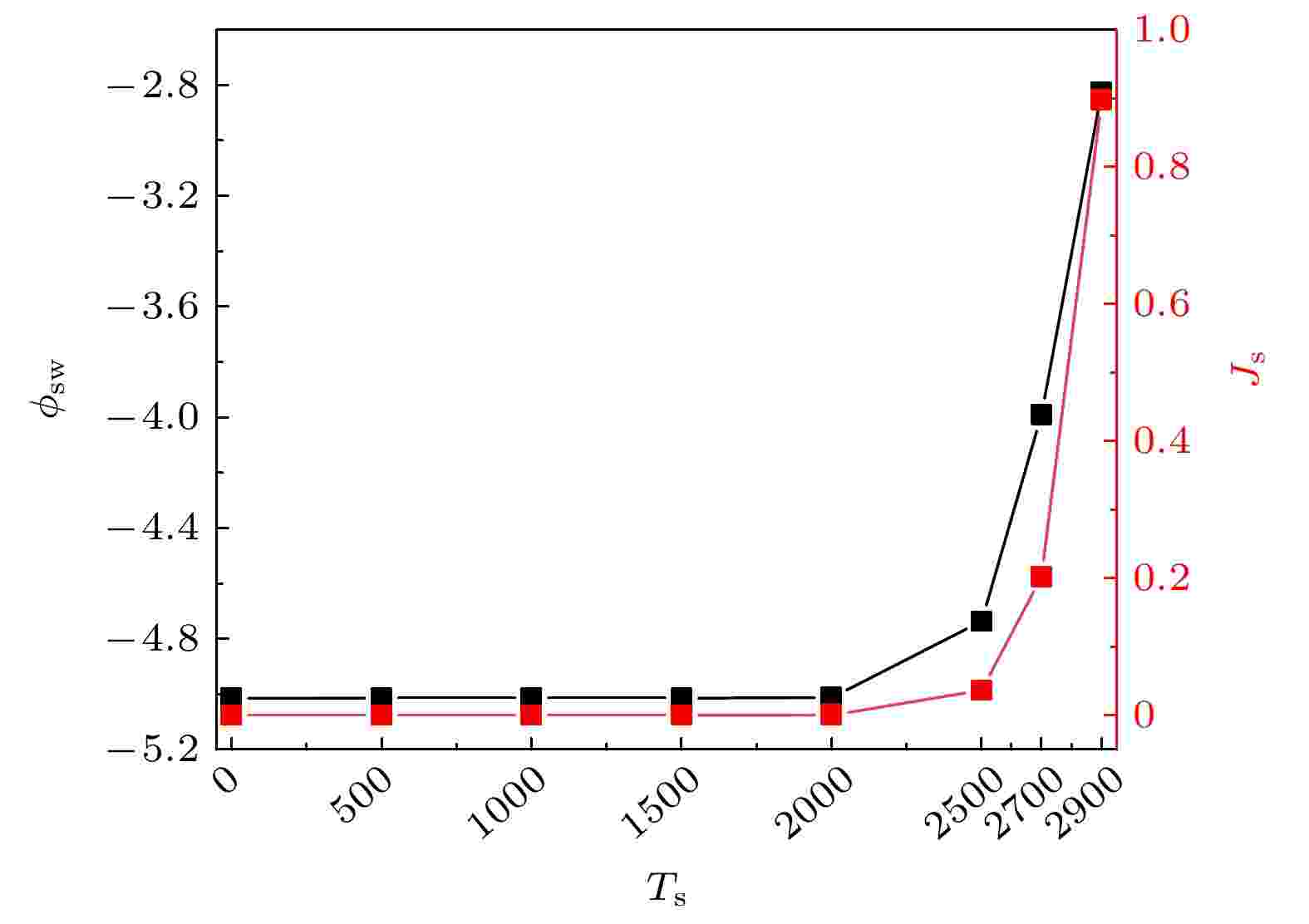
2023, 72 (15): 159401.
doi:10.7498/aps.72.20230276
Abstract +
The high confinement mode (H-mode) is a preferred operation mode of tokamak devices in the future, but the burst of edge localized mode (ELM) will sharply increase the heat load deposited on the divertor target, raising the target temperature rapidly and strengthening surface thermionic emission. In this paper, a one-dimensional fluid model is used to simulate the influence of thermionic emission on the characteristics of the magnetized sheath. The results show that the amplitude of float potential and the electric field strength both decrease under the action of thermionic emission. Plenty of thermionic emission electrons leave the target, resulting in a region with negative charge density near the target plate, and the magnetized sheath is divided into two parts: ion sheath and electron sheath. In the electron sheath, with the rise of the target surface temperature, electrons accumulated in front of the target also increase, the potential distribution is non-monotonic, and a “virtual cathode” structure appears. The reverse electric field formed near the target will confine the thermionic emission electrons leaving the target and slow down the ion movement, leading to a decrease of the ion energy deposited on the target. With the increase of the angle between the magnetic field and the target normal, the potential of the magnetized sheath and the proportion of the thickness of the electron sheath in the magnetized sheath both increase. The virtual cathode potential decreases, the temperature of the target required to form the virtual cathode rises.








